Special Report
How Federal Funding Failed to Match Each State's COVID Outbreak
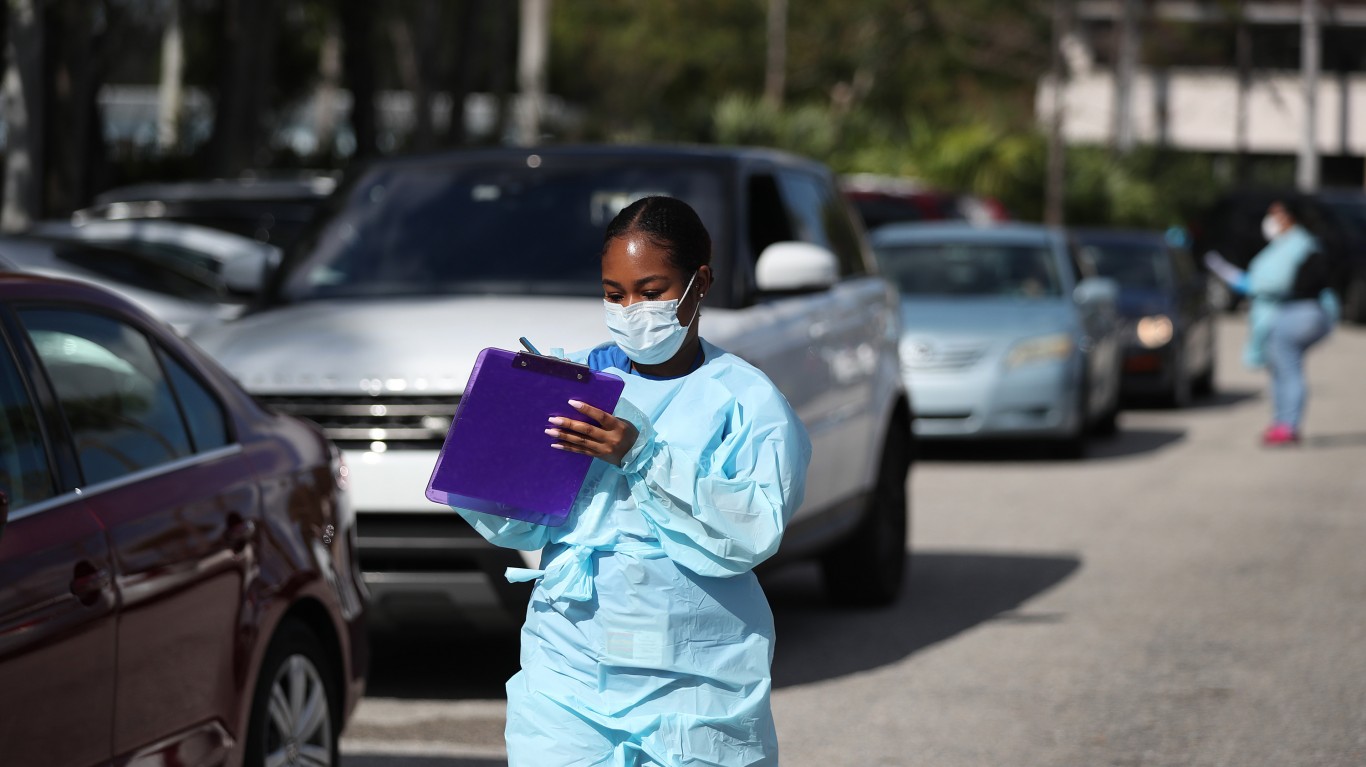
Published:
Last Updated:

The COVID-19 pandemic is a public health crisis of historic magnitude — and it has ushered in an unemployment crisis of a scope not seen since the Great Depression. To reduce the severity and longevity of the economic fallout, the federal government authorized the disbursement of $3 trillion to protect the U.S. economy. For comparison, Washington spent about $1.8 trillion over the course of five years in response to the Great Recession of 2008. Here is a list of economic crises in the U.S. that needed a massive government stimulus package.
The relief and recovery packages have provided relatively timely support to Americans and will certainly help stave off longer-term economic damage. The legislation has also been widely criticized for flaws such as prioritizing industries over workers, inadequate funding for health care, and potentially hindering people who do not typically file tax returns from applying for one-time payments.
More generally, the distribution of the funds to states has appeared especially crude — as many of the hardest hit states have not received federal funding commensurate to the severity of their public health or economic crises.
24/7 Wall St. compared federal funds allocated to each state relative to the state’s number of confirmed cases of COVID-19 and to total unemployment claims since mid-March. States are ranked from those that received the most funding relative to the scope of their problems to those that received the least. We included in our analysis funds paid to state, local, and tribal governments, as well as those distributed to individuals and businesses.
To gauge the federal government’s response in proportion to each state’s problems, we broke down the aid into two categories: money for COVID-19 testing and treatment and money for economic relief. In Alaska, a state with only 513 known cases of the virus to date, federal medical aid comes to about $2.7 million per case of the coronavirus. Meanwhile, in New York, a state with more than 375,000 cases, federal funds come to just $43,000 per case. Here is a list of the states with the highest number of COVID-19 cases.
Similarly, in Wyoming, the state with the fewest unemployment claims since mid-March, economic stimulus money to the state comes out to about $38,000 per unemployment claim. In Georgia, a state with over 2 million unemployment claims over the same time, stimulus comes out to only about $10,000 per claim. Here is a look at every state’s unemployment claims since COVID-19 shut the economy down.
Click here to see our full methodology.
Click here to see how federal funding has failed to match each state’s COVID-19 outbreak.
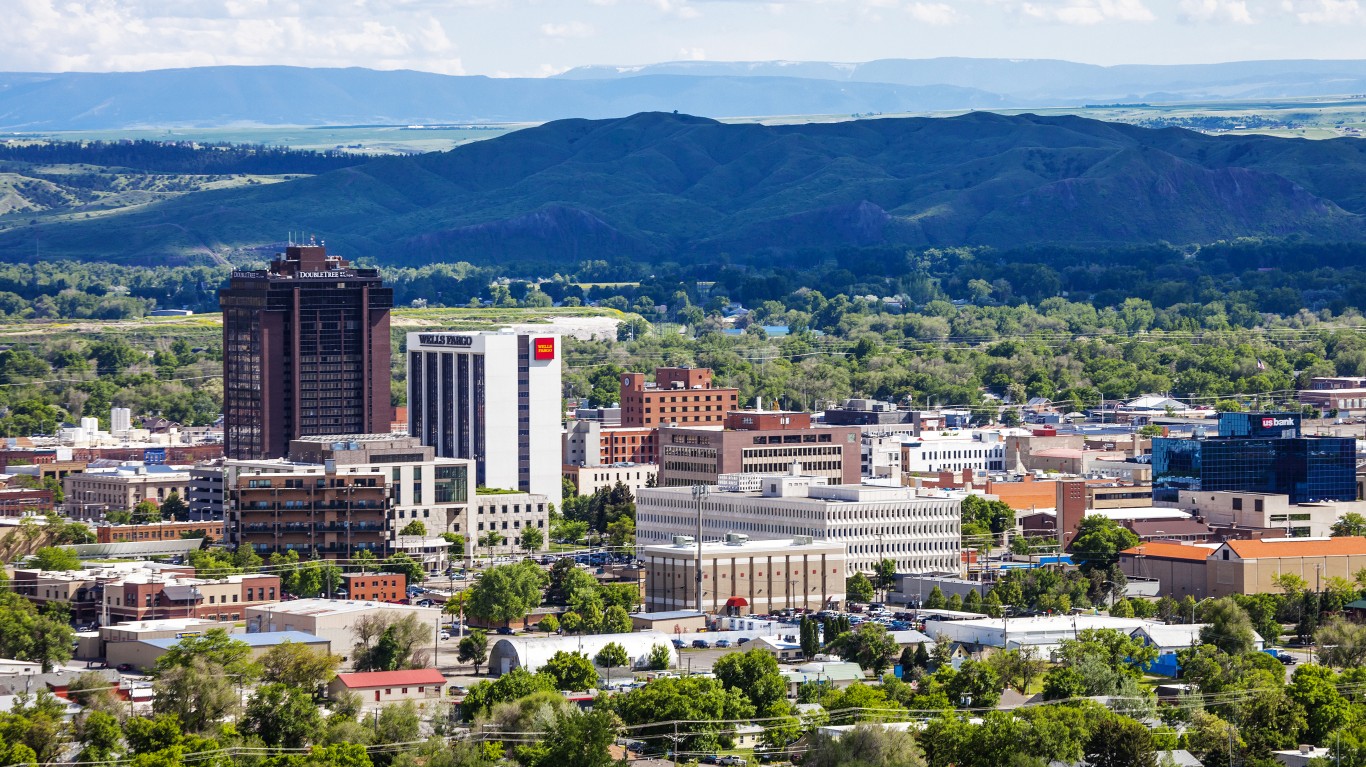
50. Montana
> Total est. federal relief funds dispersed: $4.3 billion ($4,084 per person — 7th most)
> Funds for medical care and testing: $1.4 billion ($2.6 million per COVID-19 case — 2nd most)
> Funds for general economic relief: $2.9 billion ($27,009 per initial unemployment claim as of May 30 — 12th most)
> Cumulative COVID-19 cases as of June 4: 539 (51 per 100,000 people — 2nd fewest)
> Unemployment claims from mid-March through May 30: 108,007 (20.5% of labor force — 23rd lowest)
Montana received a disproportionately high share of funding for the COVID-19 pandemic, relative to its needs. The state — and public and private entities within it — received more than $4 billion in federal funds despite having one of the lowest concentrations of COVID-19 cases and among the fewest jobless claims relative to the size of the labor force among states.
Montana’s coronavirus outbreak could be worse than reported, however. Accurate data on COVID-19 infection rates largely depends on testing capabilities, and Montana is not testing as much as most of the country. Montana is the only state to receive less than $60 million from the federal government specifically earmarked for testing. The state also has only 24 testing sites and the eighth lowest number of tests administered per capita among states.
[in-text-ad]
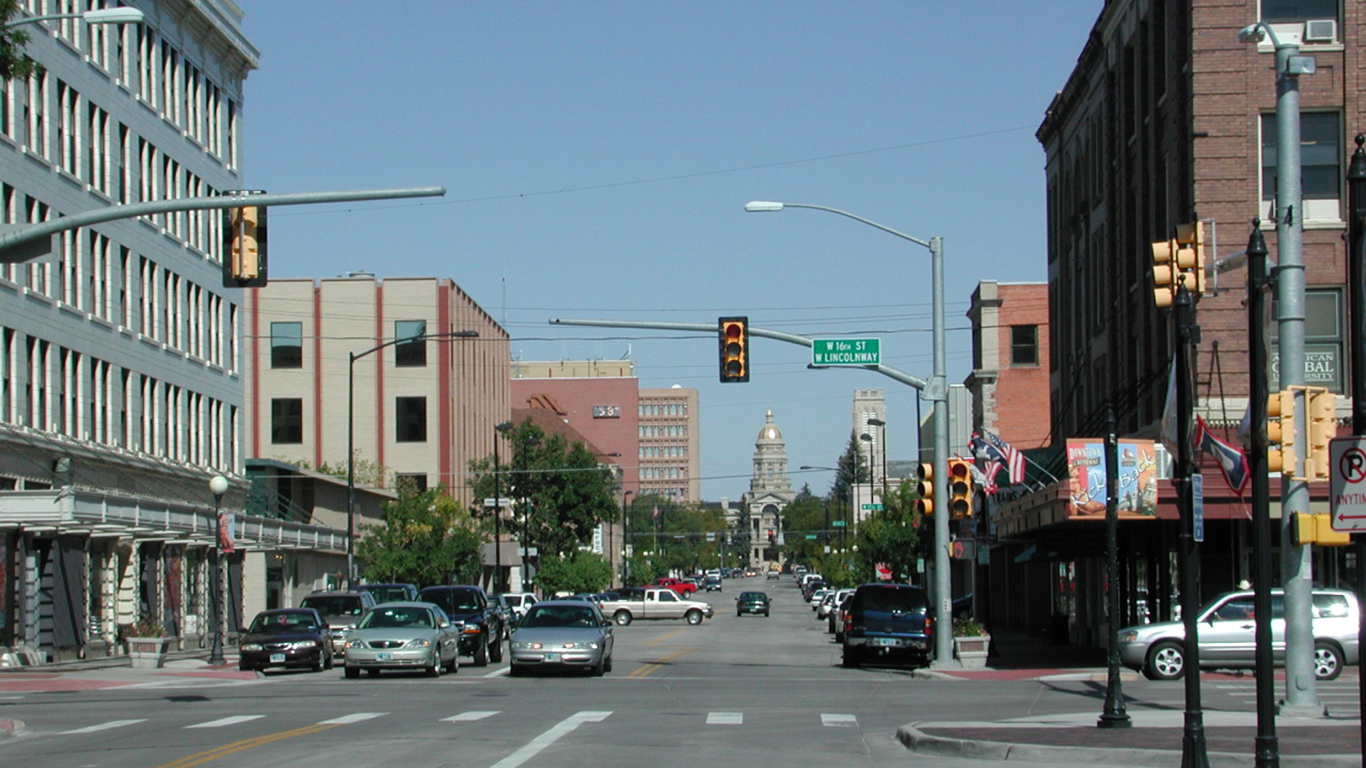
49. Wyoming
> Total est. federal relief funds dispersed: $3.0 billion ($5,234 per person — 2nd most)
> Funds for medical care and testing: $1.4 billion ($1.5 million per COVID-19 case — 4th most)
> Funds for general economic relief: $1.6 billion ($37,972 per initial unemployment claim as of May 30 — 4th most)
> Cumulative COVID-19 cases as of June 4: 921 (159 per 100,000 people — 6th fewest)
> Unemployment claims from mid-March through May 30: 43,378 (15.1% of labor force — 5th lowest)
Wyoming received nearly $3 billion in federal funding for both public health and economic stimulus during the COVID-19 pandemic. Though total federal payments to entities including individuals, businesses, local governments, and the state government was lower than nearly every other state, some of that money would likely have been better spent in other parts of the country.
Both the public health crisis and economic fallout were not as severe in Wyoming as in most of the rest of the country. As of June 4, there have been just 159 confirmed cases of COVID-19 in the state for every 100,000 people, well below the national average of 565 cases per 100,000 people. Similarly, the 43,000 unemployment claims filed in the state since mid-March amount to only about 15% of the total labor force, a smaller share than in all but four other states.
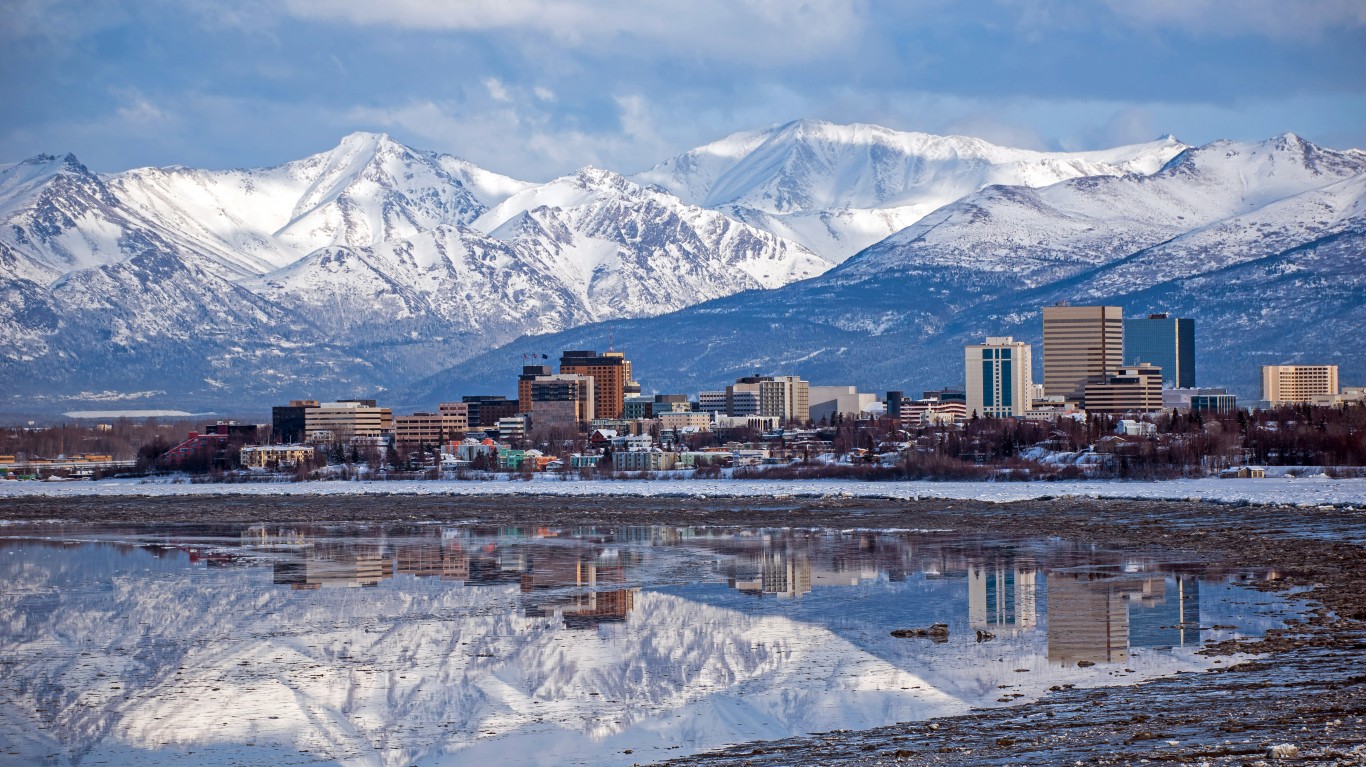
48. Alaska
> Total est. federal relief funds dispersed: $3.5 billion ($4,765 per person — 4th most)
> Funds for medical care and testing: $1.4 billion ($2.7 million per COVID-19 case — the most)
> Funds for general economic relief: $2.1 billion ($19,035 per initial unemployment claim as of May 30 — 13th least)
> Cumulative COVID-19 cases as of June 4: 513 (70 per 100,000 people — 3rd fewest)
> Unemployment claims from mid-March through May 30: 111,860 (32.4% of labor force — 6th highest)
An isolated state with the lowest population density in the country, Alaska has been largely spared the worst effects of the coronavirus. With 513 confirmed COVID-19 cases in the state to date, emergency public health funding from the federal government per case was far higher than in nearly every other state. Alaska received nearly $2.7 million per case of COVID-19 in federal money earmarked for testing and medical care, the most of any state.
Meanwhile, due in large part to Alaska’s dependence on resource extraction — an industry that was among the hardest hit by the shutdowns imposed to control the spread of the virus — joblessness has become relatively widespread in the state. Since mid-March, there have been nearly 112,000 new unemployment claims in the state, amounting to 32.4% of the total labor force, the sixth largest share among states. In keeping with the higher jobless claims, economic stimulus payments to the state have been higher than in much of the country.
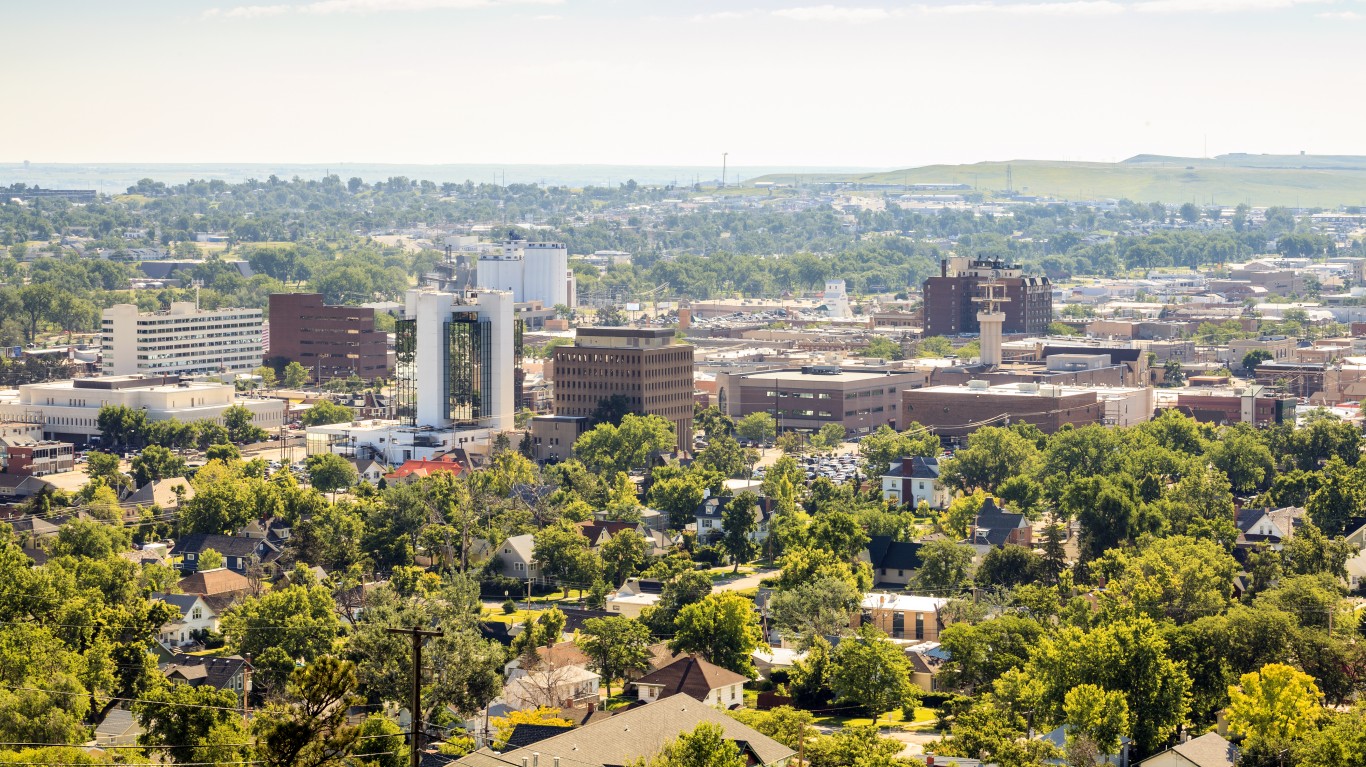
47. South Dakota
> Total est. federal relief funds dispersed: $4.0 billion ($4,532 per person — 5th most)
> Funds for medical care and testing: $1.4 billion ($276,099 per COVID-19 case — 13th most)
> Funds for general economic relief: $2.6 billion ($48,469 per initial unemployment claim as of May 30 — 2nd most)
> Cumulative COVID-19 cases as of June 4: 5,162 (585 per 100,000 people — 12th most)
> Unemployment claims from mid-March through May 30: 53,095 (11.6% of labor force — 2nd lowest)
South Dakota is one of only a handful of states that did not impose a stay-at-home order. Perhaps partially as a result, a relatively small share of the state’s labor force filed for unemployment, even as a relatively large share of the population was infected by the virus. Just over 53,000 workers in the state have filed for unemployment since mid-March, or 12% of the total labor force, the smallest share of any state. However, there have also been 585 confirmed cases of COVID-19 for every 100,000 people — a greater concentration than in all but 11 other states.
Considering the state’s relatively small number of jobless claims, South Dakota appears to have received a disproportionately large amount of federal funding for economic stimulus.
[in-text-ad-2]

46. Utah
> Total est. federal relief funds dispersed: $9.9 billion ($3,118 per person — 21st least)
> Funds for medical care and testing: $1.5 billion ($142,080 per COVID-19 case — 20th least)
> Funds for general economic relief: $8.3 billion ($48,844 per initial unemployment claim as of May 30 — the most)
> Cumulative COVID-19 cases as of June 4: 10,813 (342 per 100,000 people — 23rd fewest)
> Unemployment claims from mid-March through May 30: 170,333 (10.7% of labor force — the lowest)
While in many states, PPP payouts to small businesses have been controversial — a number of chain restaurants benefitted that are arguably not the intended targets of small business loans benefitted, for example, while many other small businesses were left without a loan — Utah is a notable exception. More than 71% of eligible small businesses in the state have been approved for a loan. Meanwhile, less than 10% of small businesses nationwide reported having received funding as of mid-April as larger national chains have drawn in much of the funding that was intended to help smaller businesses.
Utah has also received more in public health funding compared to the number of COVID-19 cases it has had than most states.

45. Hawaii
> Total est. federal relief funds dispersed: $5.5 billion ($3,845 per person — 12th most)
> Funds for medical care and testing: $1.4 billion ($2.2 million per COVID-19 case — 3rd most)
> Funds for general economic relief: $4.0 billion ($16,012 per initial unemployment claim as of May 30 — 5th least)
> Cumulative COVID-19 cases as of June 4: 655 (46 per 100,000 people — the fewest)
> Unemployment claims from mid-March through May 30: 250,816 (37.7% of labor force — 3rd highest)
Isolated from the rest of the country, Hawaii has fewer confirmed cases of COVID-19 per capita than every other state — at just 46 per 100,000 people. With a total of 655 cases as of June 4, Hawaii received $2.2 million per case in federal funds for testing and treatment, third most of all states.
Hawaii had some of the strictest lockdown rules to contain the virus, and with a large share of workers employed in tourism — a hard-hit industry — the unemployment crisis is far more severe in the state than it is in much of the rest of the country. The number of unemployment claims filed since mid-March amounts to nearly 38% of the overall labor force. Yet federal economic relief spending in the state comes out to only about $16,000 per unemployment claim, the fifth-lowest funding per claim ratios among states.
[in-text-ad]

44. Vermont
> Total est. federal relief funds dispersed: $3.2 billion ($5,118 per person — 3rd most)
> Funds for medical care and testing: $1.4 billion ($1.3 million per COVID-19 case — 5th most)
> Funds for general economic relief: $1.8 billion ($26,701 per initial unemployment claim as of May 30 — 13th most)
> Cumulative COVID-19 cases as of June 4: 1,026 (164 per 100,000 people — 7th fewest)
> Unemployment claims from mid-March through May 30: 68,739 (20.0% of labor force — 20th lowest)
Vermont is receiving more federal funding proportional to the severity of its public health crisis than most states. There have only been about 164 confirmed cases of the virus in the largely rural state for every 100,000 people, well below the national concentration of 565 per 100,000.
Still, the virus continues to spread, and much of the more than $3 billion the state received from the federal government may still be needed for the ongoing public health threat. Though new cases of the virus in the state have been sporadic and few in recent weeks, a new outbreak in Onion City is the largest Vermont has seen since April. Of the 36 new cases in the state on June 5, 34 were in Onion City. Whether the outbreak mushrooms into a larger problem remains to be seen.

43. North Dakota
> Total est. federal relief funds dispersed: $4.0 billion ($5,246 per person — the most)
> Funds for medical care and testing: $1.4 billion ($518,599 per COVID-19 case — 8th most)
> Funds for general economic relief: $2.6 billion ($35,643 per initial unemployment claim as of May 30 — 6th most)
> Cumulative COVID-19 cases as of June 4: 2,706 (356 per 100,000 people — 25th most)
> Unemployment claims from mid-March through May 30: 72,497 (18.2% of labor force — 13th lowest)
North Dakota has received about $4.0 billion total in federal aid in the wake of the pandemic — or about $5,246 per state resident, the most favorable overall ratio of any state.
Small businesses in North Dakota also benefited more than those in other states, as the Bank of North Dakota anticipated road bumps in the rollout of PPP and coordinated with and educated local banks weeks before any money was dispersed. According to Sen. Kevin Cramer, through PPP alone, South Dakota received enough federal funds to cover 72% of the state’s eligible payroll, a larger share than most other states.
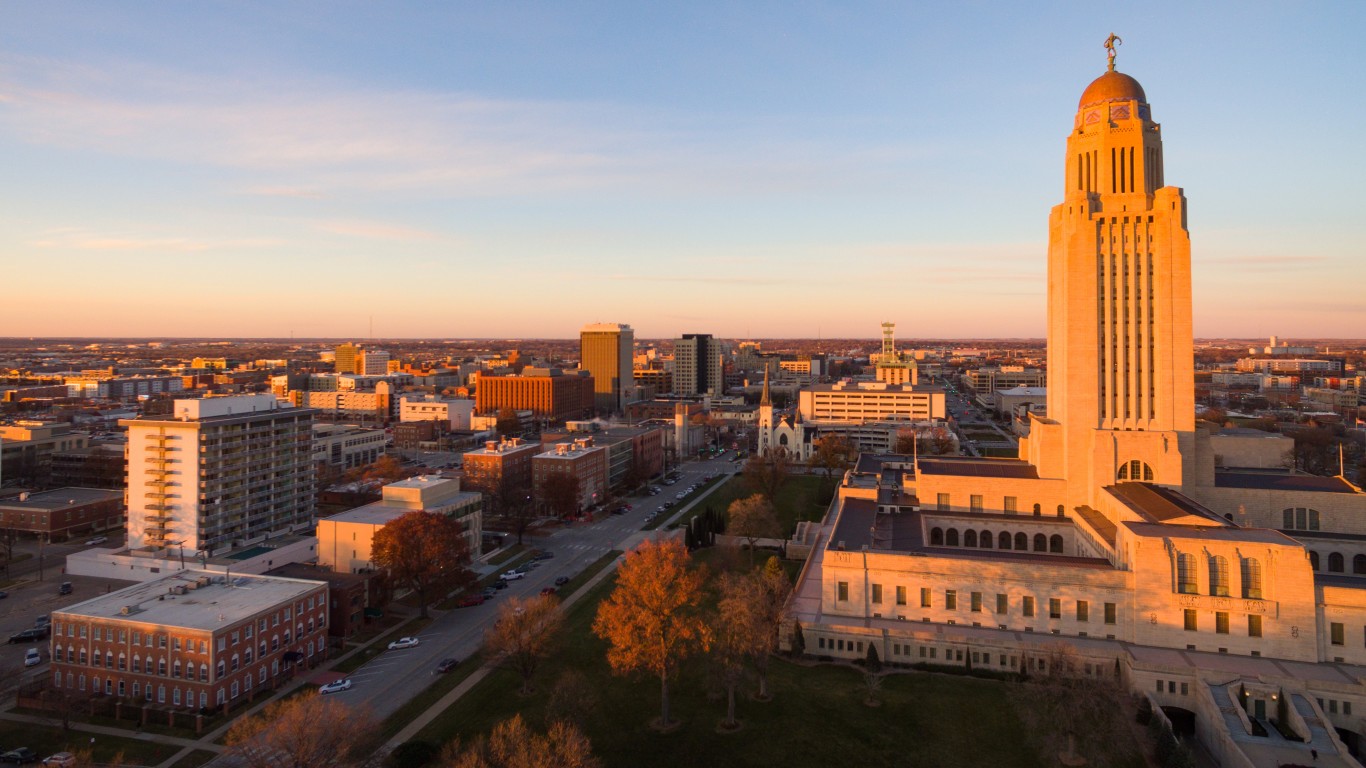
42. Nebraska
> Total est. federal relief funds dispersed: $6.9 billion ($3,577 per person — 15th most)
> Funds for medical care and testing: $1.6 billion ($103,091 per COVID-19 case — 12th least)
> Funds for general economic relief: $5.3 billion ($39,744 per initial unemployment claim as of May 30 — 3rd most)
> Cumulative COVID-19 cases as of June 4: 15,117 (784 per 100,000 people — 10th most)
> Unemployment claims from mid-March through May 30: 134,416 (13.1% of labor force — 3rd lowest)
Nebraska received far more in federal funding for economic relief than most states — relative to overall need. There have been only about 134,000 new unemployment claims in the state since the beginning of the crisis — equal to 13.1% of the state’s labor force, nearly the smallest share of any state. The $5.3 billion the state received in economic relief is equivalent to about $40,000 per unemployment claim, nearly the most of any state.
Much of the money earmarked for economic revitalization will be used in ways that will benefit residents during the crisis and long after it is over. Some $62 million of the state’s federal funding will be used for remote access capabilities, such as expansion of broadband internet to rural areas.
[in-text-ad-2]

41. Colorado
> Total est. federal relief funds dispersed: $18.8 billion ($3,304 per person — 19th most)
> Funds for medical care and testing: $2.9 billion ($105,240 per COVID-19 case — 15th least)
> Funds for general economic relief: $15.9 billion ($36,100 per initial unemployment claim as of May 30 — 5th most)
> Cumulative COVID-19 cases as of June 4: 27,360 (480 per 100,000 people — 18th most)
> Unemployment claims from mid-March through May 30: 441,484 (14.2% of labor force — 4th lowest)
Colorado received $18.8 billion in federal funds in the wake of the COVID-19 crists — most of which was earmarked for economic revitalization. However, unemployment claims resulting from efforts to contain the virus have not been as widespread in Colorado as in most other states.
Colorado Gov. Jared Polis is taking a longer term view of the state’s needs in allocating some of that funding. Through an executive order, $450 million in federal funding is going to public colleges and universities with the goal of improving retention and graduation rates and increasing the ranks of Colorado’s skilled workers.
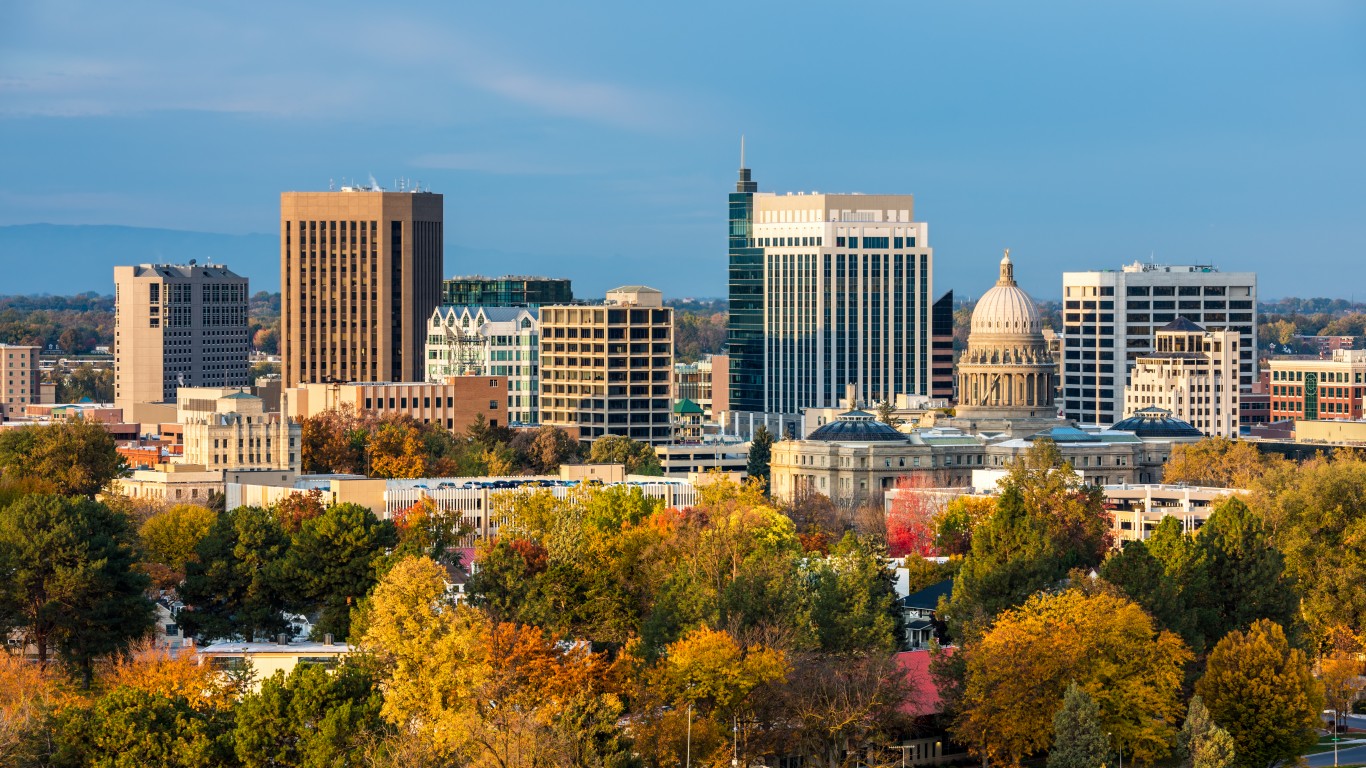
40. Idaho
> Total est. federal relief funds dispersed: $5.8 billion ($3,295 per person — 20th most)
> Funds for medical care and testing: $1.5 billion ($485,117 per COVID-19 case — 9th most)
> Funds for general economic relief: $4.3 billion ($29,964 per initial unemployment claim as of May 30 — 8th most)
> Cumulative COVID-19 cases as of June 4: 2,990 (170 per 100,000 people — 8th fewest)
> Unemployment claims from mid-March through May 30: 144,492 (16.6% of labor force — 7th lowest)
Relative to the population, the numbers of known cases of COVID-19 and of total unemployment claims since the outbreak started have been far lower in Idaho than in most other states. Because Idaho does not need as much emergency health spending or economic stimulus as many other states, the state is spending some federal funds in unconventional ways.
For example, Gov. Brad Little is using relief funds to pay for local police and fire departments. He is encouraging local municipalities to pass the savings on to residents through property tax relief. Homeowners in the state could save as much as $200 million as a result.
[in-text-ad]

39. West Virginia
> Total est. federal relief funds dispersed: $5.2 billion ($2,884 per person — 12th least)
> Funds for medical care and testing: $1.6 billion ($767,211 per COVID-19 case — 6th most)
> Funds for general economic relief: $3.6 billion ($23,018 per initial unemployment claim as of May 30 — 24th least)
> Cumulative COVID-19 cases as of June 4: 2,039 (113 per 100,000 people — 5th fewest)
> Unemployment claims from mid-March through May 30: 158,322 (20.1% of labor force — 21st lowest)
West Virginia received about $1.6 billion in federal funding for COVID-19 treatment and testing. With the state not particularly hard hit by the virus, however, that federal money comes to more than $750,000 per confirmed case of the virus, more than in all but a handful of other states.
Partially as a result, as of mid-May, the state was sitting on $1.25 billion in federal funds while waiting for approval from the White House to use the money for other purposes, such as filling budget gaps. According to estimates, West Virginia is facing a 14.4% budget shortfall through fiscal 2021 as a result of the COVID-19 crisis.

38. Texas
> Total est. federal relief funds dispersed: $81.5 billion ($2,839 per person — 10th least)
> Funds for medical care and testing: $14.0 billion ($200,249 per COVID-19 case — 18th most)
> Funds for general economic relief: $67.5 billion ($29,128 per initial unemployment claim as of May 30 — 9th most)
> Cumulative COVID-19 cases as of June 4: 69,920 (244 per 100,000 people — 13th fewest)
> Unemployment claims from mid-March through May 30: 2.3 million (16.5% of labor force — 6th lowest)
Oil and gas extraction was one of the hardest-hit industries by the COVID-19 economic shutdown — and it is an economic pillar in Texas. Still, unemployment claims in the wake of the pandemic have been relatively limited in Texas, amounting to 16.5% of the state’s labor force — a smaller share than in all but five other states. Texas has also not been hit especially hard by the virus so far compared to other states, with 244 cumulative confirmed cases per 100,000 people, less than half the average national concentration. Adjusted per unemployment claim and total cases of COVID-19, Texas received far more in federal funds than most states.

37. Illinois
> Total est. federal relief funds dispersed: $42.7 billion ($3,354 per person — 18th most)
> Funds for medical care and testing: $7.3 billion ($58,896 per COVID-19 case — 5th least)
> Funds for general economic relief: $35.4 billion ($30,935 per initial unemployment claim as of May 30 — 7th most)
> Cumulative COVID-19 cases as of June 4: 124,759 (979 per 100,000 people — 7th most)
> Unemployment claims from mid-March through May 30: 1.1 million (17.7% of labor force — 11th lowest)
Illinois ranks among the states hardest hit by the coronavirus. There have been nearly 125,000 confirmed cases of COVID-19 in the state, or nearly 1,000 per 100,000 people. The $7.3 billion Illinois received in federal funding for treatment and testing comes out to only about $59,000 per person who tested positive. The vast majority of states received more than double that amount per infection.
Illinois is in worse fiscal shape than perhaps any other state. Despite funding problems, the state is considering adding $3.7 billion to its annual budget. Federal COVID-19 relief will cover nearly all of that new spending.
[in-text-ad-2]

36. Oregon
> Total est. federal relief funds dispersed: $13.1 billion ($3,125 per person — 22nd least)
> Funds for medical care and testing: $2.0 billion ($454,172 per COVID-19 case — 10th most)
> Funds for general economic relief: $11.1 billion ($24,964 per initial unemployment claim as of May 30 — 20th most)
> Cumulative COVID-19 cases as of June 4: 4,474 (107 per 100,000 people — 4th fewest)
> Unemployment claims from mid-March through May 30: 443,272 (21.1% of labor force — 25th lowest)
Though the virus was spreading through Oregon far earlier than in much of the rest of the country, the state managed to contain the outbreak better than most other states. There were only 107 cases of COVID-19 per 100,000 people in Oregon, fewer than in all but three other states, or 4,474 cases in total. With fewer cases, the $2 billion in federal funding Oregon received for treatment and testing came out to about a half a million dollars for every confirmed case of coronavirus in the state, far more than most states.
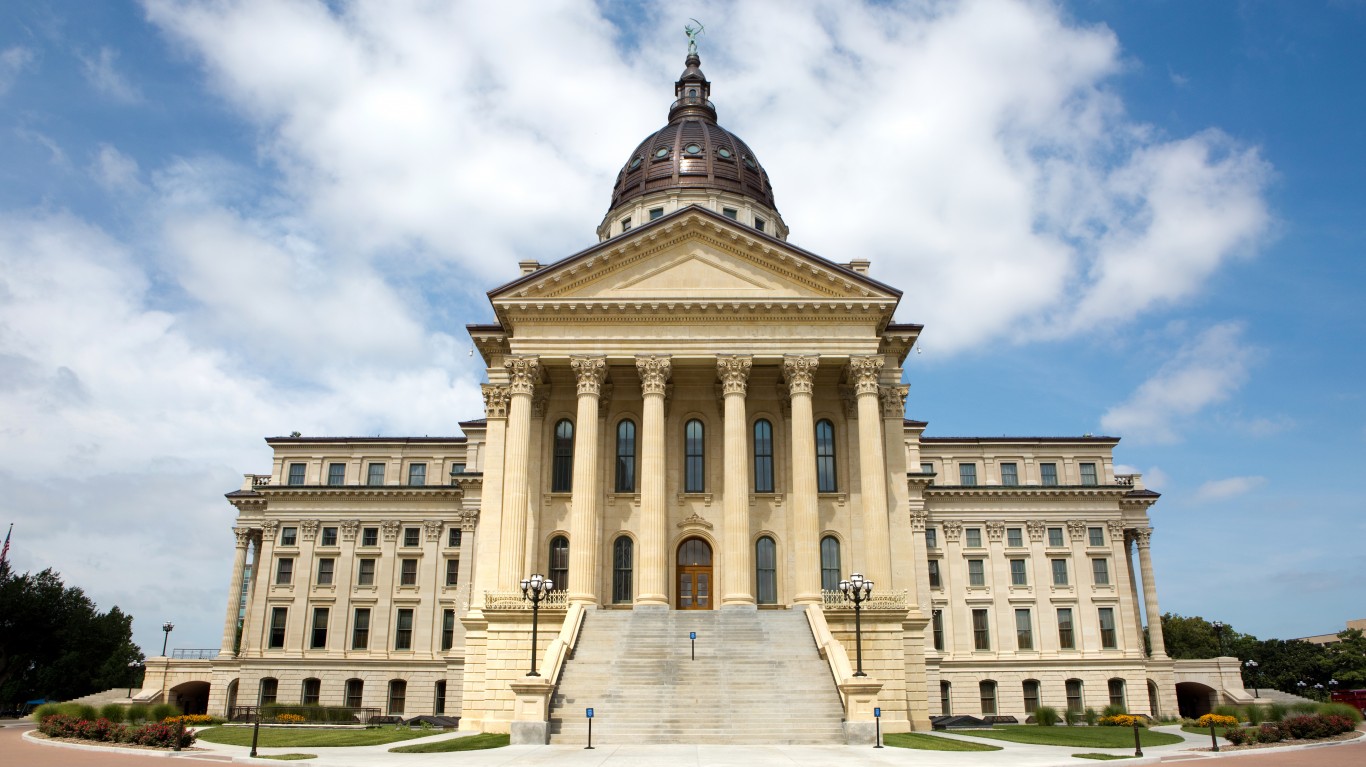
35. Kansas
> Total est. federal relief funds dispersed: $9.4 billion ($3,243 per person — 21st most)
> Funds for medical care and testing: $1.7 billion ($165,906 per COVID-19 case — 23rd most)
> Funds for general economic relief: $7.8 billion ($28,141 per initial unemployment claim as of May 30 — 10th most)
> Cumulative COVID-19 cases as of June 4: 10,170 (349 per 100,000 people — 25th fewest)
> Unemployment claims from mid-March through May 30: 275,563 (18.6% of labor force — 15th lowest)
Kansas received $9.4 billion from the federal government for economic relief and testing and treatment for COVID-19. Adjusted to the number of confirmed cases and jobless claims since the outbreak began, Kansas received more than most other states.
Gov. Laura Kelly is considering using some of that federal funding to help individuals who are struggling to afford rent or mortgage payments because of financial problems stemming from the coronavirus crisis. State lawmakers are also planning to allocate federal funds to close the state’s $650 million expected budget deficit.
[in-text-ad]

34. Maine
> Total est. federal relief funds dispersed: $5.1 billion ($3,847 per person — 11th most)
> Funds for medical care and testing: $1.5 billion ($603,011 per COVID-19 case — 7th most)
> Funds for general economic relief: $3.7 billion ($21,276 per initial unemployment claim as of May 30 — 17th least)
> Cumulative COVID-19 cases as of June 4: 2,418 (181 per 100,000 people — 10th fewest)
> Unemployment claims from mid-March through May 30: 173,477 (25.4% of labor force — 15th highest)
The $1.5 billion in federal money dispersed in Maine for purposes of COVID-19 testing and treatment comes to over $600,000 per confirmed case of the coronavirus, more than in all but half a dozen states.
While funding for the state’s public health crisis was higher than average, Maine received less money than most states for its economic woes. Since mid-March, 173,000 workers in the state filed initial unemployment claims, equal to more than one-quarter of the labor force. The $3.7 in economic stimulus the state received from Washington amounts to only about $21,000 per unemployment claim. Most states received over $23,000 per claim.

33. Tennessee
> Total est. federal relief funds dispersed: $19.3 billion ($2,852 per person — 11th least)
> Funds for medical care and testing: $3.6 billion ($143,598 per COVID-19 case — 21st least)
> Funds for general economic relief: $15.7 billion ($27,652 per initial unemployment claim as of May 30 — 11th most)
> Cumulative COVID-19 cases as of June 4: 25,120 (371 per 100,000 people — 23rd most)
> Unemployment claims from mid-March through May 30: 567,723 (17.1% of labor force — 9th lowest)
The unemployment crisis is not proving to be as severe in Tennessee as it is in many other states. Though there have been over half a million initial claims since mid-March, that comes out to only 17.1% of the state’s labor force, a smaller share than in most states. Indeed, the $15.7 billion in economic stimulus the state received from the federal government amounts to over $27,000 per jobless claim, far more than what most states received.
Recently, Gov. Bill Lee announced that state lawmakers set aside $200 million in federal funds to reimburse businesses for expenses incurred during the state’s shutdown period. More than 28,000 businesses are eligible, including many that the first round of PPP payments missed.

32. Arkansas
> Total est. federal relief funds dispersed: $7.9 billion ($2,634 per person — 2nd least)
> Funds for medical care and testing: $1.7 billion ($199,014 per COVID-19 case — 19th most)
> Funds for general economic relief: $6.3 billion ($26,615 per initial unemployment claim as of May 30 — 14th most)
> Cumulative COVID-19 cases as of June 4: 8,425 (280 per 100,000 people — 16th fewest)
> Unemployment claims from mid-March through May 30: 235,280 (17.3% of labor force — 10th lowest)
Gov. Asa Hutchinson appointed a 15-person committee to submit formal recommendations as to how the state should disperse the federal funding it received in the wake of the pandemic. So far, the committee has allocated $109.6 million to reimburse state hospitals for costs related to the outbreak, $5 million to reimburse state agencies for PPE purchases, and half a million in incentives for health care workers treating coronavirus patients.
Nearly $2.5 billion of the $7.9 billion in federal money funneled into the state went to individuals in the state in the form of Economic Impact Payments. And only a fraction of that money was allocated to be spent at the discretion of the governor.
[in-text-ad-2]

31. New Mexico
> Total est. federal relief funds dispersed: $5.8 billion ($2,774 per person — 8th least)
> Funds for medical care and testing: $1.5 billion ($181,071 per COVID-19 case — 21st most)
> Funds for general economic relief: $4.3 billion ($26,600 per initial unemployment claim as of May 30 — 15th most)
> Cumulative COVID-19 cases as of June 4: 8,353 (399 per 100,000 people — 21st most)
> Unemployment claims from mid-March through May 30: 161,663 (17.0% of labor force — 8th lowest)
Home to 22 of the 573 federally recognized tribal governments, New Mexico has a relatively large Native American population — and Native Americans have been disproportionately affected by the coronavirus. Over half of the 8,000 state residents who tested positive in the state were Native Americans. Lawmakers in Washington allocated $8 billion in funding for Native American tribal governments, and some share of that money is among the $5.8 billion New Mexico received from the federal government.
Though the money New Mexico received from the federal government is less on a per capita basis than what most other states received, it is more than most states when adjusted for cases of the virus and the number of jobless claims filed since the beginning of the pandemic.
30. Missouri
> Total est. federal relief funds dispersed: $18.4 billion ($3,010 per person — 18th least)
> Funds for medical care and testing: $3.2 billion ($230,576 per COVID-19 case — 14th most)
> Funds for general economic relief: $15.2 billion ($24,935 per initial unemployment claim as of May 30 — 21st most)
> Cumulative COVID-19 cases as of June 4: 14,057 (229 per 100,000 people — 11th fewest)
> Unemployment claims from mid-March through May 30: 609,490 (19.9% of labor force — 19th lowest)
Missouri had a total of 229 confirmed COVID-19 cases per 100,000 residents as of June 4, the 11th lowest infection rate of any state. Like most states with a low incidence of COVID-19, Missouri has received outsized funding for coronavirus-related care and testing. To date, Missouri has received approximately $3.2 billion in federal funds for COVID-19 medical care and testing. With a total of just over 14,000 cases, this amount comes to $320,576 per COVID-19 case, the 14th highest funding of any state.
Including funds for coronavirus-related economic relief, Missouri has received an estimated $18.4 billion from the federal government, approximately in line with the national average when adjusted for population.
[in-text-ad]

29. Wisconsin
> Total est. federal relief funds dispersed: $18.5 billion ($3,183 per person — 24th most)
> Funds for medical care and testing: $2.9 billion ($146,848 per COVID-19 case — 22nd least)
> Funds for general economic relief: $15.6 billion ($25,463 per initial unemployment claim as of May 30 — 19th most)
> Cumulative COVID-19 cases as of June 4: 19,892 (342 per 100,000 people — 24th fewest)
> Unemployment claims from mid-March through May 30: 611,965 (19.7% of labor force — 18th lowest)
One area in which Wisconsin has received an outsized amount of funding is indirect payments to individuals and businesses. Adult Wisconsin residents have received $4.9 billion in personal stimulus checks as of May 22, the eighth most of any state when adjusted for population. Similarly, businesses have received a total of $9.8 billion in PPP loans as of May 30, the 17th most of any state per capita.
Despite the payments, many businesses in Wisconsin are still struggling. According to a survey by advocacy group Startup Wisconsin, 40.6% of startups in the state have either frozen hiring or reduced workforce due to COVID-19. Consumer confidence is currently lower in Wisconsin than in all but nine other states, according to June data from market research firm Morning Consult.

28. Virginia
> Total est. federal relief funds dispersed: $25.0 billion ($2,930 per person — 15th least)
> Funds for medical care and testing: $4.4 billion ($97,340 per COVID-19 case — 11th least)
> Funds for general economic relief: $20.5 billion ($25,550 per initial unemployment claim as of May 30 — 18th most)
> Cumulative COVID-19 cases as of June 4: 45,620 (536 per 100,000 people — 17th most)
> Unemployment claims from mid-March through May 30: 802,990 (18.3% of labor force — 14th lowest)
While Virginia has received an estimated $25.0 billion in coronavirus-related federal relief funds — roughly in line with the national average when adjusted for population — the state has received relatively little funding for COVID-19 medical care and testing. Across four programs — the Coronavirus Relief Fund, the Public Health and Social Services Emergency Fund, the COVID-19 High Impact Allocation, and CDC funding for COVID-19 testing — Virginia has received about $4.4 billion for care and testing. Adjusted for the number of infections, this comes out to $97,340 per confirmed COVID-19 case, the 11th lowest of any state.
Lack of funding may have impeded Virginia’s testing efforts to date. As of June 4, the state had performed 4,125 COVID-19 tests per 100,000 people, the third lowest testing rate nationwide.

27. Arizona
> Total est. federal relief funds dispersed: $19.1 billion ($2,663 per person — 5th least)
> Funds for medical care and testing: $3.7 billion ($164,025 per COVID-19 case — 25th most)
> Funds for general economic relief: $15.4 billion ($24,443 per initial unemployment claim as of May 30 — 24th most)
> Cumulative COVID-19 cases as of June 4: 22,753 (317 per 100,000 people — 21st fewest)
> Unemployment claims from mid-March through May 30: 628,769 (17.9% of labor force — 12th lowest)
Arizona has received relatively little in indirect relief payments to individuals and businesses. As of May 22, the state had received $5.6 billion in individual stimulus checks to individuals, the 12th least when adjusted for population. Similarly, businesses received $8.4 billion in PPP loans, the eighth least of any state per capita.
But while Arizona has received smaller amounts in economic relief funding per capita than most other states, the state also may have less need. Since March 15, 628,769 Arizonans have filed for unemployment, amounting to 17.9% of the labor force — the 12th smallest share of any state. As of June 4, there were 317 confirmed COVID-19 cases per 100,000 Arizona residents, far less than the national rate of 565 cases per 100,000 Americans.
[in-text-ad-2]

26. Connecticut
> Total est. federal relief funds dispersed: $12.3 billion ($3,455 per person — 17th most)
> Funds for medical care and testing: $2.3 billion ($52,129 per COVID-19 case — 4th least)
> Funds for general economic relief: $10.1 billion ($25,956 per initial unemployment claim as of May 30 — 16th most)
> Cumulative COVID-19 cases as of June 4: 43,239 (1,210 per 100,000 people — 5th most)
> Unemployment claims from mid-March through May 30: 388,740 (20.5% of labor force — 24th lowest)
As of June 4, Connecticut had 1,210 confirmed COVID-19 cases per 100,000 residents, the fifth highest infection rate of any state. Like many of the states with the worst coronavirus outbreaks, Connecticut has received disproportionately low funding for COVID-19 care and testing relative to most other states. Across four programs — the Coronavirus Relief Fund, the Public Health and Social Services Emergency Fund, the COVID-19 High Impact Allocation, and CDC funding for COVID-19 testing — Connecticut has received $2.3 billion for COVID-19 medical care and testing. This amounts to $52,129 per COVID-19 case, the fourth least of any state.
In economic relief funds, however, the state received $10.1 billion through programs like PPP loans to businesses, EIP payments to individuals, and FTA Transit Infrastructure Grants to urbanized areas. When adjusted for unemployment claims, Connecticut received more in economic stimulus than most states.
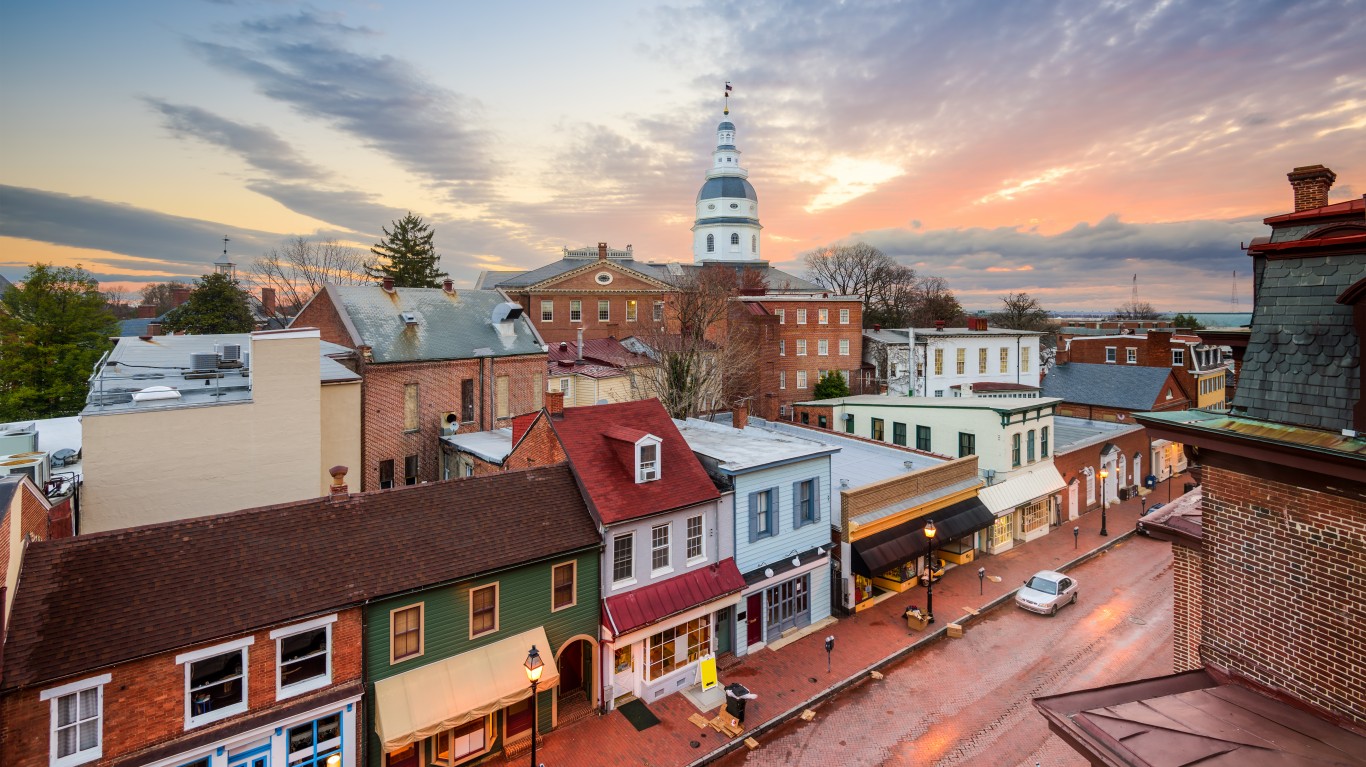
25. Maryland
> Total est. federal relief funds dispersed: $19.0 billion ($3,144 per person — 25th least)
> Funds for medical care and testing: $3.4 billion ($61,261 per COVID-19 case — 6th least)
> Funds for general economic relief: $15.6 billion ($25,757 per initial unemployment claim as of May 30 — 17th most)
> Cumulative COVID-19 cases as of June 4: 55,858 (924 per 100,000 people — 8th most)
> Unemployment claims from mid-March through May 30: 604,849 (18.7% of labor force — 16th lowest)
As of June 4, there were 924 confirmed COVID-19 cases per 100,000 residents in Maryland, the eighth highest concentration of any state. Many of the federal relief programs for COVID-19 care and testing are allocated according to population and not infection rate, potentially leaving states with the worst outbreaks like Maryland with inadequate funding. To date, Maryland has received $3.4 billion in funding for medical care and testing. This comes to $61,261 per COVID-19 case, the sixth lowest funding per case of any state.
In general economic relief, however, Maryland has fared better. The economic fallout from COVID-19 has been relatively small in Maryland, with UI claims since mid-March amounting to 18.7% of the labor force — one of the smaller shares of any state. Maryland has received some $15.6 billion in general economic relief so far, the 17th most when adjusted for UI claims.
[in-text-ad]

24. Iowa
> Total est. federal relief funds dispersed: $9.9 billion ($3,129 per person — 23rd least)
> Funds for medical care and testing: $1.7 billion ($80,275 per COVID-19 case — 8th least)
> Funds for general economic relief: $8.2 billion ($24,472 per initial unemployment claim as of May 30 — 23rd most)
> Cumulative COVID-19 cases as of June 4: 20,706 (656 per 100,000 people — 11th most)
> Unemployment claims from mid-March through May 30: 335,587 (19.5% of labor force — 17th lowest)
Iowa is one state that has likely suffered from the blunt funding formulas used to disburse federal coronavirus relief funds. Due to outbreaks in cities like Sioux City and Des Moines, Iowa has emerged as one of the major hot spots for COVID-19, with 656 confirmed cases per 100,000 residents as of June 4 — the 11th highest infection concentration of any state.
Iowa received the minimum $1.25 billion from the Coronavirus Relief Fund — public health payments disbursed to state, local, and tribal governments — according to its population. In total, Iowa has received some $1.7 billion for COVID-19 care and testing, the eighth least of any state when adjusted for case count.

23. Delaware
> Total est. federal relief funds dispersed: $3.9 billion ($4,056 per person — 8th most)
> Funds for medical care and testing: $1.5 billion ($155,296 per COVID-19 case — 23rd least)
> Funds for general economic relief: $2.4 billion ($23,264 per initial unemployment claim as of May 30 — 25th most)
> Cumulative COVID-19 cases as of June 4: 9,746 (1,008 per 100,000 people — 6th most)
> Unemployment claims from mid-March through May 30: 103,571 (21.4% of labor force — 24th highest)
While Delaware is home to one of the worst coronavirus outbreaks in the country — with 1,008 COVID-19 cases per 100,000 people as of June 4, the sixth highest concentration of any state — it has received funding for medical care and testing in line with the national average. To date, Delaware has received some $1.5 billion for COVID-19 medical care and testing. This comes to $155,296 per COVID-19 case, ranking 28th among all 50 states.
Similarly, Delaware has received an average amount of funding to deal with the economic fallout of coronavirus. The state has received some $2.4 billion in economic relief payments to date, which amounts to $23,264 for every unemployment claim filed since mid-March — about the median amount among states.
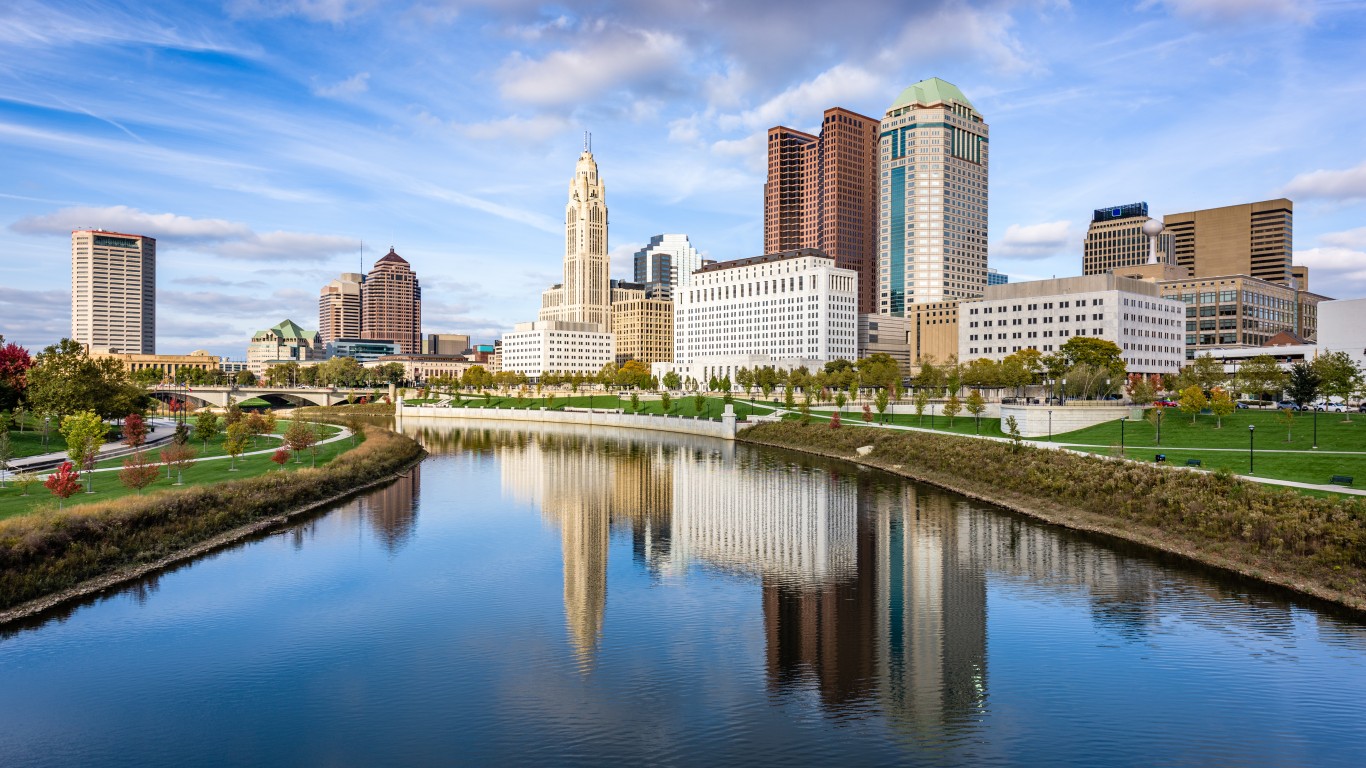
22. Ohio
> Total est. federal relief funds dispersed: $35.8 billion ($3,059 per person — 19th least)
> Funds for medical care and testing: $5.9 billion ($157,103 per COVID-19 case — 24th least)
> Funds for general economic relief: $29.9 billion ($22,969 per initial unemployment claim as of May 30 — 23rd least)
> Cumulative COVID-19 cases as of June 4: 37,282 (319 per 100,000 people — 22nd fewest)
> Unemployment claims from mid-March through May 30: 1.3 million (22.6% of labor force — 23rd highest)
Ohio has received coronavirus relief funding nearly matching the size of the outbreak in the state and economic fallout — at least in proportion to other states. As of June 4, there were 319 confirmed COVID-19 cases per 100,000 residents in Ohio, ranking 29th out of all 50 states. To date, Ohio has received $5.9 billion in federal funding to address the public health consequences of coronavirus. With over 37,000 cases, this amounts to $157,103 per COVID-19 case, ranking 27th across all states.
Since March 15, some 1.3 million there have been 1.3 million unemployment claims in Ohio, representing 22.6% of the labor force. Through programs like PPP loans, personal stimulus checks, and emergency UI funding, Ohio has received some $29.9 billion in general economic relief — amounting to $22,969 per UI claim, ranking 28th out of all states.
[in-text-ad-2]

21. New York
> Total est. federal relief funds dispersed: $76.7 billion ($3,926 per person — 9th most)
> Funds for medical care and testing: $16.0 billion ($42,725 per COVID-19 case — 2nd least)
> Funds for general economic relief: $60.7 billion ($24,513 per initial unemployment claim as of May 30 — 22nd most)
> Cumulative COVID-19 cases as of June 4: 375,133 (1,920 per 100,000 people — the most)
> Unemployment claims from mid-March through May 30: 2.5 million (25.9% of labor force — 14th highest)
While New York has received an estimated $76.7 billion in federal relief funds — more than any state other than Texas and California — the sum may be inadequate relative to the severity of the coronavirus outbreak in the state. New York is the epicenter of the COVID-19 pandemic, with 1,920 confirmed cases per 100,000 residents as of June 4, the most of any state.
And while New York has received substantial funding from programs distributed according to need or demand, such as FEMA disaster relief, FTA Transit Infrastructure Grants, and COVID-19 High Impact Allocation payments to hospitals, funding still came up short. In total, New York has received $16.0 billion in funding for medical care and testing. Adjusted for infections, this comes to $42,725 per COVID-19 case, the second least of any state and less than half the national average.

20. Minnesota
> Total est. federal relief funds dispersed: $19.4 billion ($3,461 per person — 16th most)
> Funds for medical care and testing: $2.9 billion ($109,073 per COVID-19 case — 17th least)
> Funds for general economic relief: $16.6 billion ($23,049 per initial unemployment claim as of May 30 — 25th least)
> Cumulative COVID-19 cases as of June 4: 26,273 (468 per 100,000 people — 20th most)
> Unemployment claims from mid-March through May 30: 718,236 (23.3% of labor force — 22nd highest)
Minnesota was hit harder by the COVID-19 pandemic than most states — both from a public health perspective and an economic one. Partially as a result, the more than $19 billion the state received in federal funds may not have been sufficient to match the severity of the crisis.
Public health funding in the state came out to about $109,000 for every known case of the virus, less than in most other states. Similarly, economic stimulus money came out to about $23,000 per unemployment claim filed since mid-March, closest to the middle among all states.
[in-text-ad]

19. North Carolina
> Total est. federal relief funds dispersed: $27.5 billion ($2,646 per person — 4th least)
> Funds for medical care and testing: $5.3 billion ($165,275 per COVID-19 case — 24th most)
> Funds for general economic relief: $22.2 billion ($21,578 per initial unemployment claim as of May 30 — 19th least)
> Cumulative COVID-19 cases as of June 4: 31,966 (308 per 100,000 people — 20th fewest)
> Unemployment claims from mid-March through May 30: 1.0 million (20.3% of labor force — 22nd lowest)
North Carolina is one of several states that serves as a case study of how some federal funds may have been misappropriated in the wake of the pandemic. Because of its infectious nature and to reserve hospital resources for COVID-19 patients, hospitals around the country had to halt nonemergency procedures at the height of the outbreak. This eliminated elective surgeries and many other services that hospitals rely on for funding.
In North Carolina, more than $600 million in federal aid went to hospitals — but the majority of the money went to just four major hospitals with billions in reserve money between them, leaving smaller hospitals struggling to pay the bills.

18. California
> Total est. federal relief funds dispersed: $124.1 billion ($3,137 per person — 24th least)
> Funds for medical care and testing: $19.4 billion ($162,051 per COVID-19 case — 25th least)
> Funds for general economic relief: $104.7 billion ($21,566 per initial unemployment claim as of May 30 — 18th least)
> Cumulative COVID-19 cases as of June 4: 119,807 (303 per 100,000 people — 19th fewest)
> Unemployment claims from mid-March through May 30: 4.9 million (25.0% of labor force — 17th highest)
By far the largest state by population, California received the most federal aid of any state, at over $124 billion. While the $19.4 billion in medical aid — or $162,000 per case of the virus in the state — is close to the median need-based funding among all states, the economic stimulus money sent to California may not have been enough.
Since mid-March, 4.9 million Californians have filed for unemployment — equal to about a quarter of the labor force. The $104.7 billion in economic stimulus money from Washington amounts to less than $22,000 per unemployment claim, less money than most states.
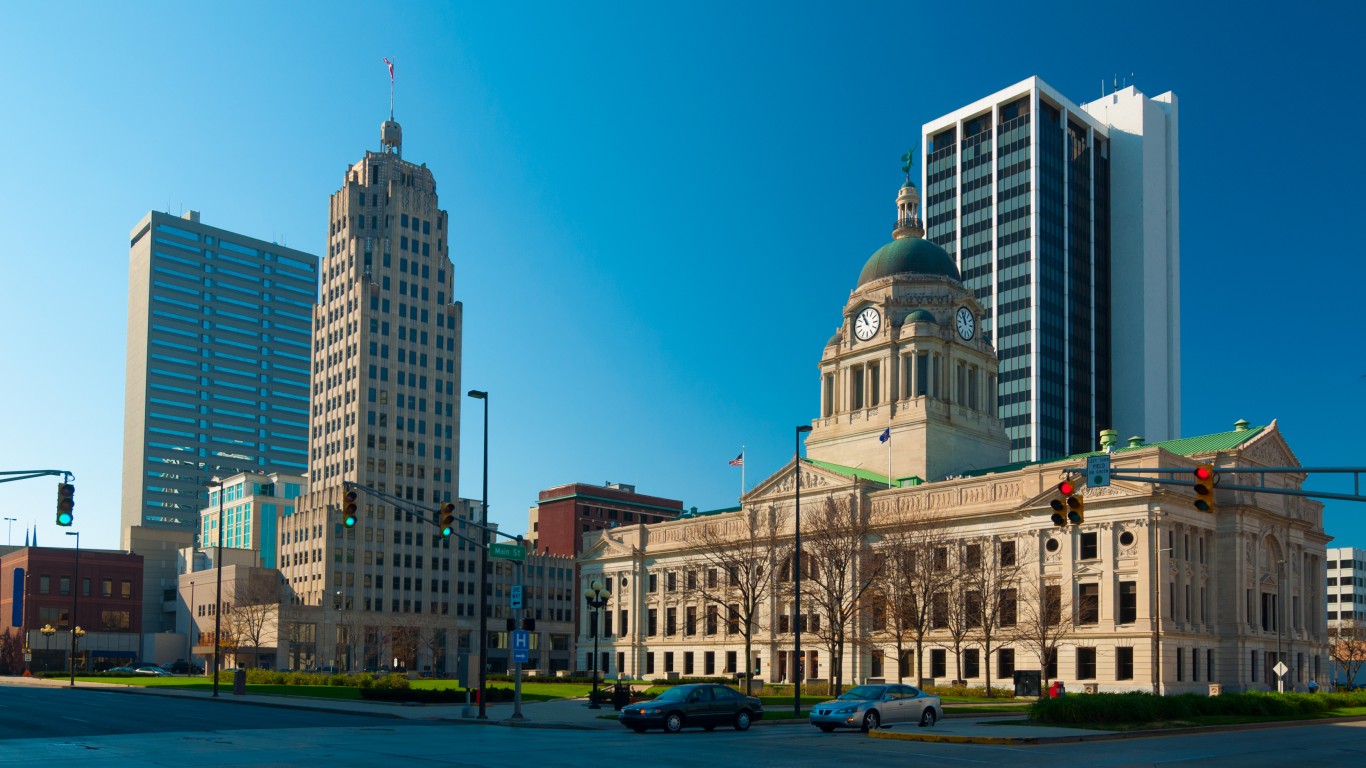
17. Indiana
> Total est. federal relief funds dispersed: $19.8 billion ($2,952 per person — 16th least)
> Funds for medical care and testing: $3.7 billion ($103,308 per COVID-19 case — 13th least)
> Funds for general economic relief: $16.0 billion ($22,204 per initial unemployment claim as of May 30 — 20th least)
> Cumulative COVID-19 cases as of June 4: 36,096 (539 per 100,000 people — 16th most)
> Unemployment claims from mid-March through May 30: 721,691 (21.3% of labor force — 25th highest)
Indiana received $3.7 billion in relief funds for COVID-19 treatment and testing. This comes out to about $103,000 for every confirmed case of the coronavirus, which is less than what all but a dozen other states received.
Like many other states, Indiana is using some of its federal funding to improve its long-term economic prospects. No state relies more on manufacturing than Indiana, and Indiana is allocating $10 million to technology and operational advancements in the manufacturing sector.
[in-text-ad-2]

16. Massachusetts
> Total est. federal relief funds dispersed: $25.6 billion ($3,708 per person — 14th most)
> Funds for medical care and testing: $4.4 billion ($43,231 per COVID-19 case — 3rd least)
> Funds for general economic relief: $21.2 billion ($22,623 per initial unemployment claim as of May 30 — 22nd least)
> Cumulative COVID-19 cases as of June 4: 102,063 (1,479 per 100,000 people — 3rd most)
> Unemployment claims from mid-March through May 30: 936,258 (24.6% of labor force — 19th highest)
Massachusetts is one of several states in the Northeast to rank among the hardest hit by the virus. There have been over 100,000 cases of the virus in the state, or nearly 1,500 per 100,000 people — more than double the national concentration. Federal funding for COVID-19 treatment and testing has not been proportional to the severity and scope of the problem. Massachusetts received $4.4 billion federal medical aid, or about $43,000 for every known infection. Most states received well more than double that amount.
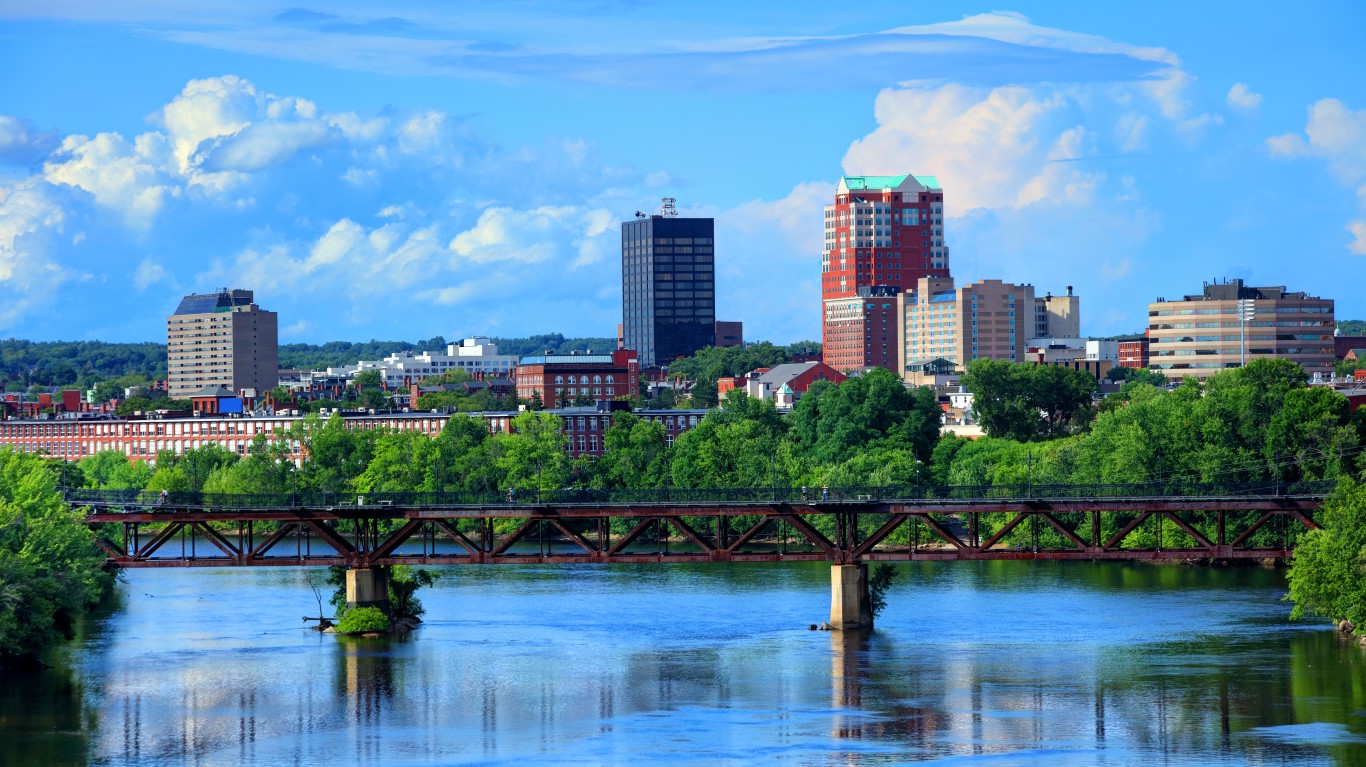
15. New Hampshire
> Total est. federal relief funds dispersed: $5.3 billion ($3,922 per person — 10th most)
> Funds for medical care and testing: $1.5 billion ($304,755 per COVID-19 case — 12th most)
> Funds for general economic relief: $3.8 billion ($18,687 per initial unemployment claim as of May 30 — 12th least)
> Cumulative COVID-19 cases as of June 4: 4,876 (359 per 100,000 people — 24th most)
> Unemployment claims from mid-March through May 30: 205,152 (26.7% of labor force — 12th highest)
New Hampshire is one of only 16 states where the total number of initial unemployment claims since mid-March is equal to more than one-quarter of the state’s total labor force. The $3.8 billion economic stimulus sent to the state from Washington may not be enough to match the severity of New Hampshire’s unemployment crisis, as that amount comes to only about $19,000 per unemployment claim, less than what most other states received.
Federal funding for COVID-19 treatment and testing in New Hampshire is more closely in line with the median amount per case across all states.
[in-text-ad]

14. New Jersey
> Total est. federal relief funds dispersed: $33.2 billion ($3,728 per person — 13th most)
> Funds for medical care and testing: $6.7 billion ($41,359 per COVID-19 case — the least)
> Funds for general economic relief: $26.5 billion ($22,501 per initial unemployment claim as of May 30 — 21st least)
> Cumulative COVID-19 cases as of June 4: 162,530 (1,824 per 100,000 people — 2nd most)
> Unemployment claims from mid-March through May 30: 1.2 million (26.4% of labor force — 13th highest)
New Jersey is one of several states in the Northeast to rank among the hardest hit by the virus. There have been over 162,000 cases of the virus in the state, or more than 1,824 per 100,000 people — more than triple the national concentration. Federal funding for COVID-19 treatment and testing has not been proportional to the severity and scope of the problem. New Jersey received $6.7 billion in federal medical aid, or about $41,000 for every known infection, the least per case of any state. Most states received well more than double that amount.

13. Florida
> Total est. federal relief funds dispersed: $63.5 billion ($2,980 per person — 17th least)
> Funds for medical care and testing: $11.3 billion ($188,217 per COVID-19 case — 20th most)
> Funds for general economic relief: $52.1 billion ($20,100 per initial unemployment claim as of May 30 — 16th least)
> Cumulative COVID-19 cases as of June 4: 60,183 (283 per 100,000 people — 17th fewest)
> Unemployment claims from mid-March through May 30: 2.6 million (25.3% of labor force — 16th highest)
Based on the number of jobless claims filed in the state since mid-March, the total economic relief Florida received from the federal government of $52.1 billion may have fallen short of its needs. Since the lockdown and other measures began taking a serious toll on American workers, 2.6 million Floridian workers have filed for unemployment. The federal government’s economic stimulus payments to the state amounts to only about $20,000 per unemployment claim, less than most other states.
The state’s Orange County, home to the city of Orlando, created an online portal for individuals and small businesses to apply to receive federal CARES Act funding through the portal. In less than 15 minutes after the portal began taking applications on Monday, it shut down due to an overwhelming volume of applications, numbering in the thousands within the first few minutes.

12. Oklahoma
> Total est. federal relief funds dispersed: $11.4 billion ($2,898 per person — 13th least)
> Funds for medical care and testing: $2.2 billion ($313,075 per COVID-19 case — 11th most)
> Funds for general economic relief: $9.3 billion ($17,442 per initial unemployment claim as of May 30 — 8th least)
> Cumulative COVID-19 cases as of June 4: 6,907 (175 per 100,000 people — 9th fewest)
> Unemployment claims from mid-March through May 30: 531,225 (29.0% of labor force — 11th highest)
Oklahoma’s economy is heavily dependent on industries that have been hard hit by the economic fallout resulting from the pandemic, and these industries employ a relatively large proportion of workers in the state. As a result, the unemployment crisis is more severe in the state than in most other parts of the country — and the $9.3 billion in federal economic relief the state received may not match the severity of the crisis. The federal funds amount comes out to only $17,442 per unemployment claim filed since the beginning of the pandemic — less than most other states.
Some $145 million of the federal funds are going to Oklahoma’s public school districts. Schools will have discretion as to how to use the money. The federal money is allowing districts to close budget gaps.
[in-text-ad-2]

11. Alabama
> Total est. federal relief funds dispersed: $13.5 billion ($2,754 per person — 7th least)
> Funds for medical care and testing: $2.6 billion ($136,053 per COVID-19 case — 19th least)
> Funds for general economic relief: $10.9 billion ($19,919 per initial unemployment claim as of May 30 — 15th least)
> Cumulative COVID-19 cases as of June 4: 18,766 (384 per 100,000 people — 22nd most)
> Unemployment claims from mid-March through May 30: 547,548 (24.4% of labor force — 20th highest)
As a share of the total population and labor force, Alabama had more confirmed cases of COVID-19 cases and more unemployment claims, respectively, than most other states. Partially as a result, the amount of federal money the state received from the federal government based on the state’s medical and economic needs was less than most other states.
Much of the money allocated specifically to the state government is meant to be used explicitly to cover expenses related to COVID-19. However, some leaders in the state senate proposed allocating $200 million of it for a new statehouse — an idea Gov. Kay Ivey rejected.
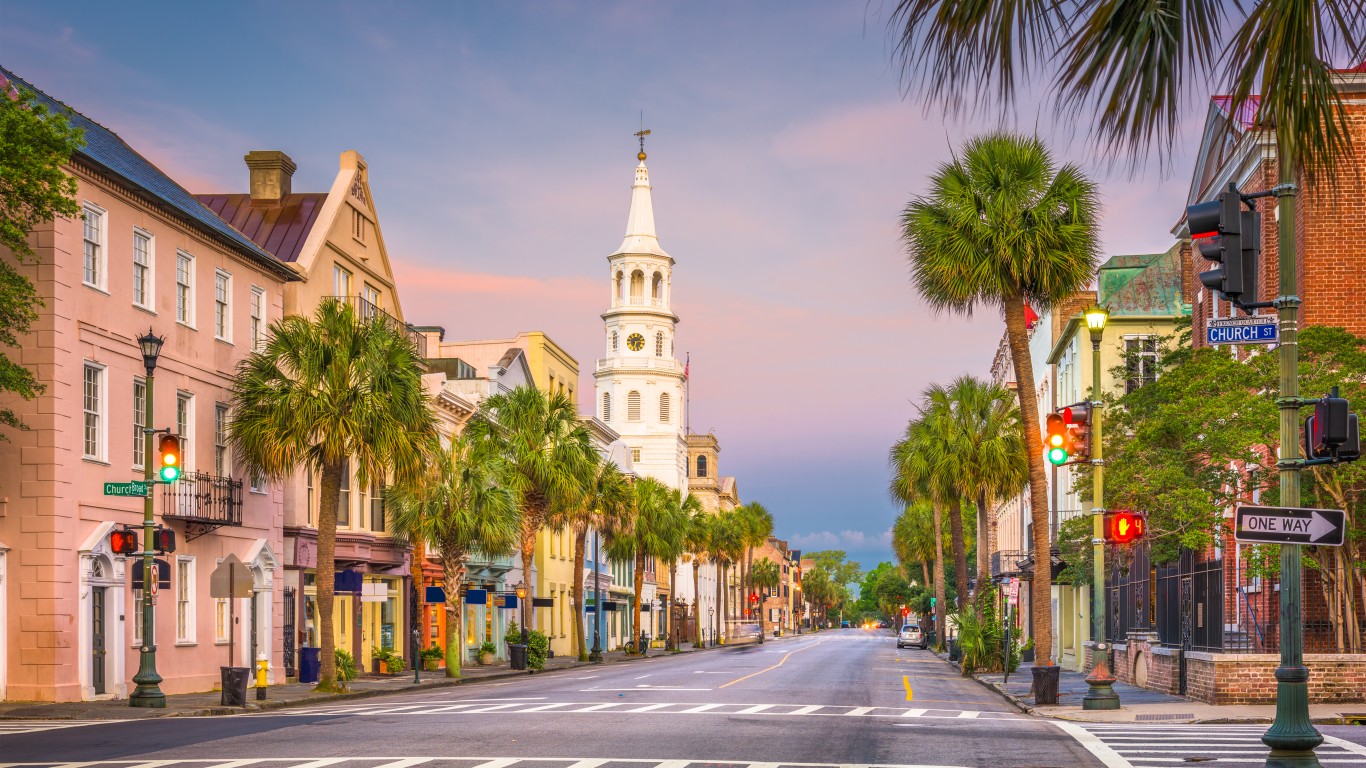
10. South Carolina
> Total est. federal relief funds dispersed: $13.3 billion ($2,616 per person — the least)
> Funds for medical care and testing: $2.7 billion ($203,924 per COVID-19 case — 16th most)
> Funds for general economic relief: $10.6 billion ($18,617 per initial unemployment claim as of May 30 — 11th least)
> Cumulative COVID-19 cases as of June 4: 13,005 (256 per 100,000 people — 14th fewest)
> Unemployment claims from mid-March through May 30: 571,996 (24.2% of labor force — 21st highest)
South Carolina received some $2.7 billion in federal aid for COVID-19 testing and treatment. This comes out to about $204,000 for each of the 13,000 confirmed cases in the state — more money than most states received per case.
As far as economic stimulus money is concerned, however, South Carolina may have been shortchanged. The state received the equivalent of about $18,600 for each of the more than half a million unemployment claims filed since the beginning of the pandemic. Meanwhile, the vast majority of states received more than $20,000 per claim, and a handful received more than $30,000.
[in-text-ad]

9. Mississippi
> Total est. federal relief funds dispersed: $7.9 billion ($2,643 per person — 3rd least)
> Funds for medical care and testing: $1.7 billion ($105,295 per COVID-19 case — 16th least)
> Funds for general economic relief: $6.1 billion ($19,479 per initial unemployment claim as of May 30 — 14th least)
> Cumulative COVID-19 cases as of June 4: 16,560 (554 per 100,000 people — 15th most)
> Unemployment claims from mid-March through May 30: 315,665 (24.9% of labor force — 18th highest)
As a share of the total population and labor force, Mississippi had more confirmed cases of COVID-19 and more unemployment claims, respectively, than most other states. Partially as a result, the amount of federal money the state received from the federal government based on the state’s medical and economic needs was less than most other states.
The amount of funding per COVID-19 case does not even factor in the recent surge of infections. While cases of COVID-19 have been dropping in much of the country, Mississippi recently reported the most new infections in a single date — nearly 500 on June 8.

8. Rhode Island
> Total est. federal relief funds dispersed: $4.5 billion ($4,226 per person — 6th most)
> Funds for medical care and testing: $1.5 billion ($95,172 per COVID-19 case — 10th least)
> Funds for general economic relief: $3.0 billion ($17,468 per initial unemployment claim as of May 30 — 10th least)
> Cumulative COVID-19 cases as of June 4: 15,325 (1,449 per 100,000 people — 4th most)
> Unemployment claims from mid-March through May 30: 172,323 (31.2% of labor force — 9th highest)
Rhode Island ranks among the top five states for most unemployment claims as a share of the labor force since the beginning of the pandemic and among the 10 worst states for coronavirus infections per capita.
The state received $3.0 billion in federal funds for economic relief — or only about $17,500 per case of unemployment claim since mid-March. Meanwhile, the vast majority of states received more than $20,000 per claim, and a handful received more than $30,000. According to a recent study released by the nonprofit Rhode Island Public Expenditure Council, the state’s unemployment insurance trust will run out of funds as early as September.

7. Pennsylvania
> Total est. federal relief funds dispersed: $40.9 billion ($3,192 per person — 23rd most)
> Funds for medical care and testing: $7.0 billion ($94,388 per COVID-19 case — 9th least)
> Funds for general economic relief: $33.9 billion ($17,120 per initial unemployment claim as of May 30 — 7th least)
> Cumulative COVID-19 cases as of June 4: 73,942 (577 per 100,000 people — 14th most)
> Unemployment claims from mid-March through May 30: 2.0 million (30.7% of labor force — 10th highest)
Pennsylvania is one of only 10 states where the number of unemployment claims filed since mid-March amounts to over 30% of the state’s total labor force. Though the state has received a staggering $33.9 billion in federal funding to stimulate the economy, that amount may not be sufficient. Pennsylvania has received the equivalent of only $17,120 per jobless claim, far less than what most states have received.
As of late May, the state had yet to spend some of the federal aid it had been allocated. Under current spending rules, Pennsylvania cannot use federal money to make up for lost revenue. State lawmakers are hoping to change that rule soon, however, as by some estimates, revenue losses may amount to as much as $5 billion over the next 12 months.
[in-text-ad-2]

6. Louisiana
> Total est. federal relief funds dispersed: $14.8 billion ($3,177 per person — 25th most)
> Funds for medical care and testing: $2.9 billion ($69,477 per COVID-19 case — 7th least)
> Funds for general economic relief: $11.9 billion ($17,443 per initial unemployment claim as of May 30 — 9th least)
> Cumulative COVID-19 cases as of June 4: 41,562 (892 per 100,000 people — 9th most)
> Unemployment claims from mid-March through May 30: 683,254 (32.8% of labor force — 4th highest)
A staggering 683,000 people have filed for unemployment insurance in Louisiana since the beginning of the pandemic — equal to nearly one-third of the state’s total labor force. Given the severity and scope of the state’s jobless crisis, the $11.9 billion funneled into the state from Washington D.C. may not be enough, as it comes out to only about $17,400 per unemployment claim — far less than what most states received.
Louisiana has also had far more cases of the coronavirus per capita than most other states. The $2.9 billion in federal medical relief aid the state received comes out to just under $70,000 per confirmed case of COVID-19. Most states received over $100,000 per case.
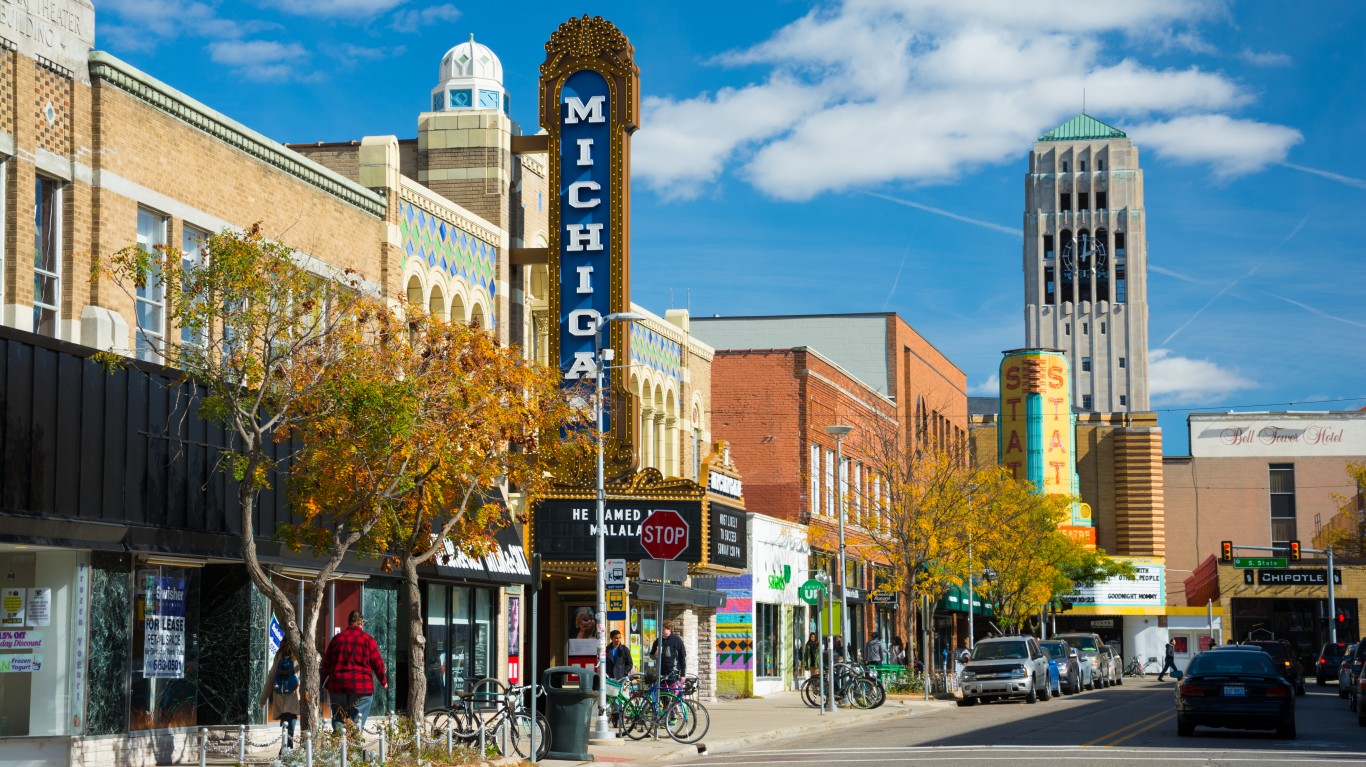
5. Michigan
> Total est. federal relief funds dispersed: $32.0 billion ($3,199 per person — 22nd most)
> Funds for medical care and testing: $6.1 billion ($104,089 per COVID-19 case — 14th least)
> Funds for general economic relief: $25.9 billion ($16,798 per initial unemployment claim as of May 30 — 6th least)
> Cumulative COVID-19 cases as of June 4: 58,241 (583 per 100,000 people — 13th most)
> Unemployment claims from mid-March through May 30: 1.5 million (31.3% of labor force — 8th highest)
Federal economic stimulus money allocated to Michigan has not likely been enough to match the scope of the crisis in the state. Since mid-March, there have been 1.5 million unemployment claims in Michigan — equal to nearly one-third of the state’s labor force. The $25.9 billion in economic stimulus money given to the state comes to less than $17,000 per unemployment claim — a smaller adjusted amount than in all but five other states.
Due to lost tax revenue, the Michigan School Aid fund is projected to have a $1.3 billion decline in revenue. If no action is taken, this could lead to budget cuts equivalent to $700 per pupil annually — meaning massive layoffs in the state’s public education system.
[in-text-ad]

4. Washington
> Total est. federal relief funds dispersed: $23.4 billion ($3,112 per person — 20th least)
> Funds for medical care and testing: $3.8 billion ($169,813 per COVID-19 case — 22nd most)
> Funds for general economic relief: $19.6 billion ($15,514 per initial unemployment claim as of May 30 — 4th least)
> Cumulative COVID-19 cases as of June 4: 22,484 (298 per 100,000 people — 18th fewest)
> Unemployment claims from mid-March through May 30: 1.3 million (32.6% of labor force — 5th highest)
Washington state received $19.6 billion in federal economic relief aid. When adjusted to the state’s near nation-leading jobless problem, however, this comes out to only about $15,500 per unemployment claim filed since mid-march, a lower adjusted amount than in all but three other states.
The state’s high unemployment is having a ripple effect that could drain state coiffers. Over the next three years, Washington state is projected to face a $7 billion deficit. As a result, state lawmakers are expected to hold a special session to decide on budget cuts that could affect anything from education, to nursing homes, to government employee salaries.
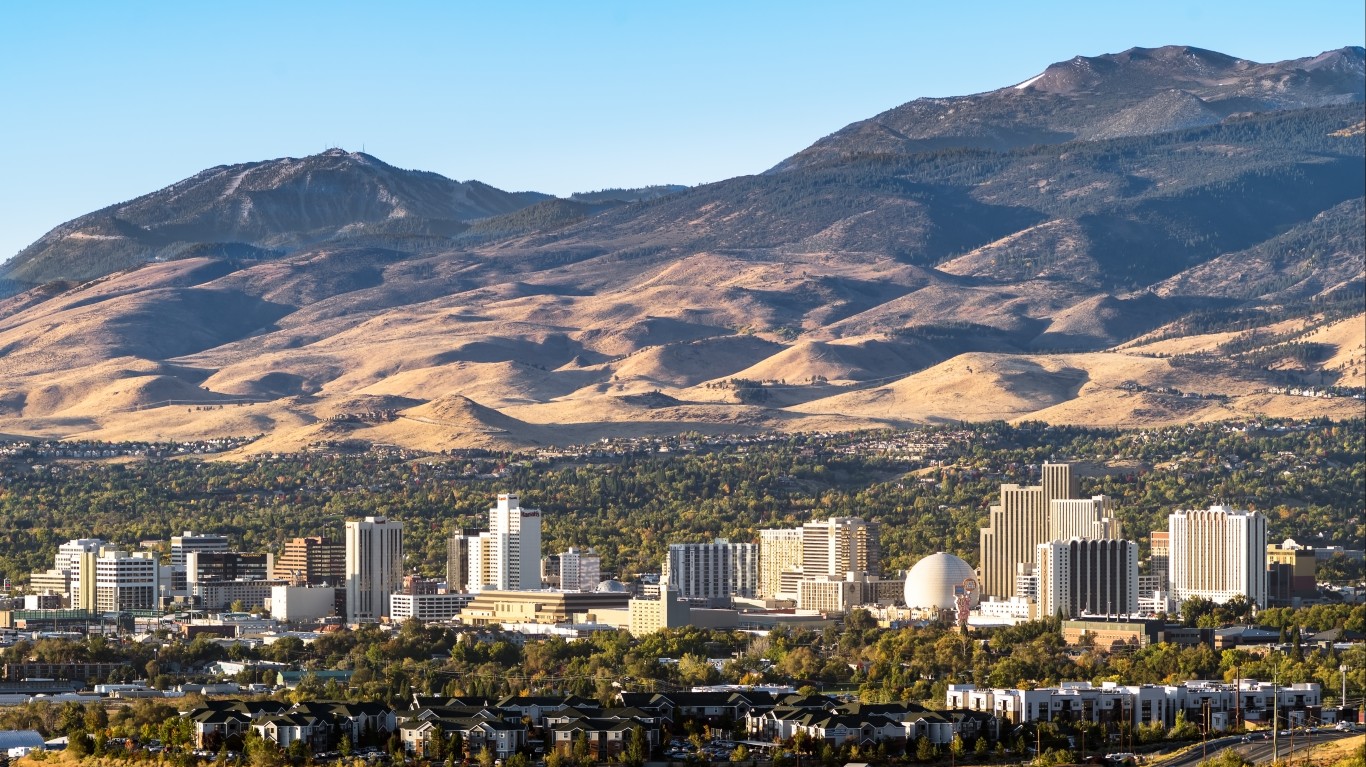
3. Nevada
> Total est. federal relief funds dispersed: $8.8 billion ($2,916 per person — 14th least)
> Funds for medical care and testing: $1.6 billion ($201,627 per COVID-19 case — 17th most)
> Funds for general economic relief: $7.2 billion ($14,860 per initial unemployment claim as of May 30 — 3rd least)
> Cumulative COVID-19 cases as of June 4: 8,000 (264 per 100,000 people — 15th fewest)
> Unemployment claims from mid-March through May 30: 486,922 (31.8% of labor force — 7th highest)
Tourism is a pillar of the Nevada economy, and few industries have been hit harder by the COVID-19 pandemic than tourism. Nevada is the only state in which more than one-third of the labor force is employed in industries bearing the brunt of the COVID-19 recession, like tourism. Not surprisingly, the state’s unemployment crisis is more severe than it is in much of the rest of the country. There have been nearly half a million unemployment claims since mid-March in Nevada, representing a far larger share of the state’s labor force than most states. As a result, the federal economic stimulus money Nevada received is spread relatively thin.
The economic decline means lost revenue for the state. In late May, the governor’s office requested that department heads submit plans for 5% budget reductions in order to avoid layoffs in the public sector.
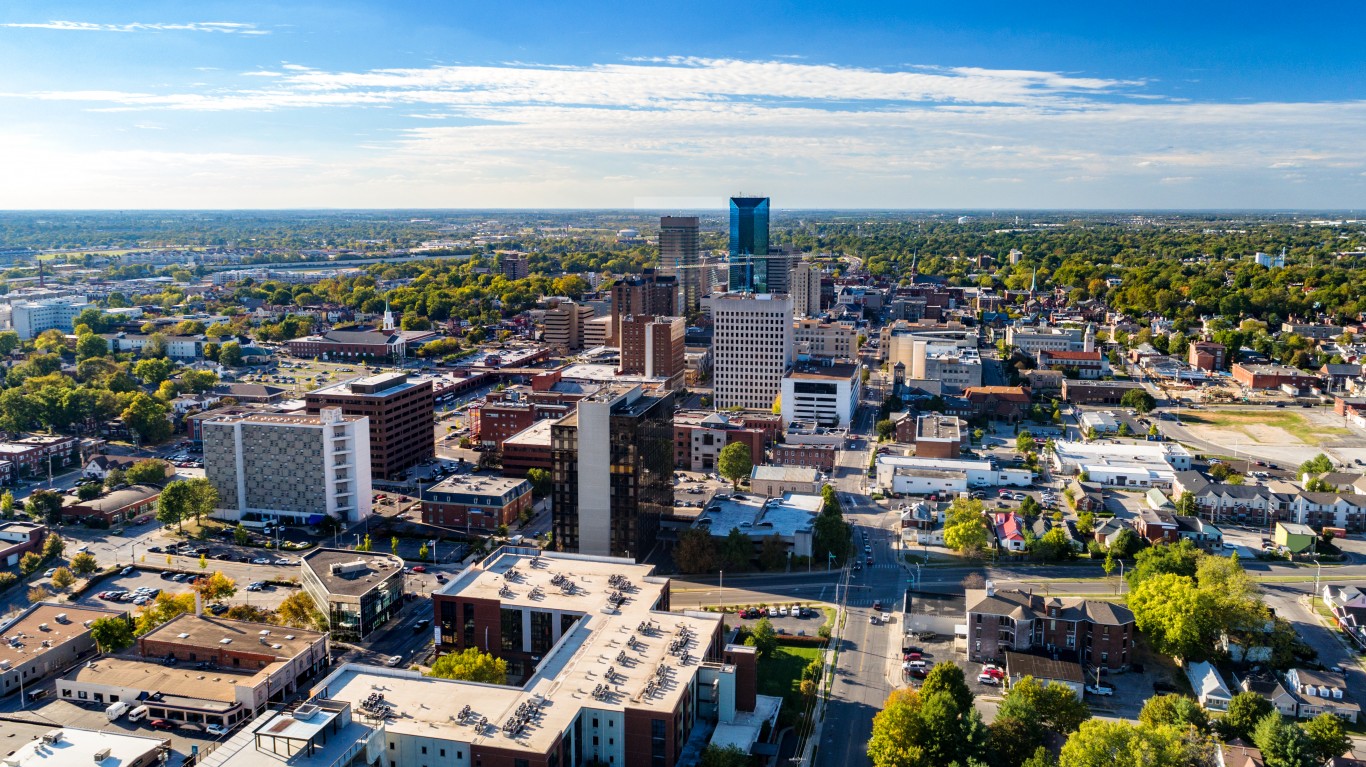
2. Kentucky
> Total est. federal relief funds dispersed: $12.1 billion ($2,706 per person — 6th least)
> Funds for medical care and testing: $2.3 billion ($214,726 per COVID-19 case — 15th most)
> Funds for general economic relief: $9.8 billion ($10,777 per initial unemployment claim as of May 30 — 2nd least)
> Cumulative COVID-19 cases as of June 4: 10,705 (240 per 100,000 people — 12th fewest)
> Unemployment claims from mid-March through May 30: 908,505 (44.2% of labor force — 2nd highest)
While Kentucky has had one of the smaller coronavirus outbreaks of any state — there were 240 confirmed cases per 100,000 as of June 4, the 12th fewest per capita nationwide — the state has had one of the worst economic fallouts from the pandemic. Since March 15, 908,505 Kentuckians have filed for unemployment — amounting to 44.2% of the labor force, the second largest share nationwide. Moody’s projects the state will have a 16.5% budget shortfall in fiscal 2021, the seventh largest contraction of any state.
Through programs like PPP loans to businesses, personal stimulus checks, UI emergency funding, and others, Kentucky has received an estimated $9.8 billion in economic relief funding. This comes to just $10,777 per UI claim, the second lowest funding per claim of any state.
[in-text-ad-2]

1. Georgia
> Total est. federal relief funds dispersed: $29.9 billion ($2,839 per person — 9th least)
> Funds for medical care and testing: $5.6 billion ($111,779 per COVID-19 case — 18th least)
> Funds for general economic relief: $24.3 billion ($10,144 per initial unemployment claim as of May 30 — the least)
> Cumulative COVID-19 cases as of June 4: 49,998 (475 per 100,000 people — 19th most)
> Unemployment claims from mid-March through May 30: 2.4 million (46.9% of labor force — the highest)
While the spread of COVID-19 in Georgia has been relatively mild compared to the nation as a whole, the state has had one of the worst economic fallouts. Since March 15, 2.4 million Georgia residents have filed for unemployment benefits, equivalent to 46.9% of the labor force — the largest share of any state.
Though Georgia has received an estimated $24.3 billion through direct and indirect relief programs like PPP loans, economic stimulus checks, and FTA Transit Infrastructure Grants, when adjusted for the size of the local economic crisis, it pales in comparison to other states. Overall, Georgia has received just $10,144 in general economic relief funding per UI claim, the least of any state and less than half the national average.
Methodology
To determine how adequately federal funding matches each state’s COVID-19 outbreak, 24/7 Wall St. reviewed data on the allocation of funding from the Coronavirus Preparedness and Response Supplemental Appropriations Act, the Families First Coronavirus Response Act, the Coronavirus Aid, Relief, and Economic Security (CARES) Act, and the Paycheck Protection program and Health Care Enhancement Act. We grouped relief programs into two categories — funding for COVID-19 medical care and testing, and funding for general economic relief — and then adjusted the former for the number of confirmed COVID-19 case counts as of June 4, 2020 using data from state and local health departments, and adjusted the latter for the number of initial unemployment insurance claims from March. 15, 2020 to May 30, 2020 using data from the U.S. Department of Labor. We then created an index based on the two adjusted measures — funding for COVID-19 medical care and testing per confirmed COVID-19 case and funding for general economic relief per UI claim — and ranked all 50 states.
The programs counted in the COVID-19 medical care and testing funding total include:
> Direct aid paid to state, local, and tribal governments through the Coronavirus Relief Fund of the CARES Act
> The value of initial Public Health and Social Services Emergency Fund payments to health care providers through CARES Act
> The value of COVID-19 High Impact Allocation payments to hospitals through the Provider Relief Fund of the CARES Act
> Direct payments made to state, local, and tribal governments for COVID-19 testing through Coronavirus Preparedness and Response Supplemental Appropriations Act
> Direct payments made to state, local, and tribal governments for COVID-19 testing through the CARES Act
> Direct payments made to state, local, and tribal governments for COVID-19 testing through Payment Protection Program and Health Care Enhancement Act
The programs counted in the general economic relief funding total include:
> The value of all Paycheck Protection Program loans approved for small businesses as of May 30, 2020 through the CARES Act
> The value of all Economic Impact Payment payments paid to individuals as of May 22, 2020 through the CARES Act
> Direct payments to states for UI emergency funding through Families First Coronavirus Response Act
> Estimated direct payments to states through the Governor’s Emergency Education Relief Fund of the CARES Act
> Estimated direct payments to states through the Elementary and Secondary School Emergency Relief Fund of the CARES Act
> Estimated direct payments to states through IHE grants through the Higher Education Emergency Relief Fund of the CARES Act
> FEMA disaster relief allocations as of Apr. 30, 2020
> FTA Transit Infrastructure Grant allocations through CARES Act
> Payments to airports made as of Apr. 15, 2020 through the Airport Improvement Program through the CARES Act
> Direct payments made to state and local governments as of May 22, 2020 through HUD Community Development Block Grants through the CARES Act
> Direct payments allocated to state and local governments as of May 22, 2020 through HUD Emergency Solutions Grants through the CARES Act
> Direct payments allocated to state and tribal governments as of Apr. 15, 2020 through HHS Child Care & Development Block Grants through CARES Act
Supplemental data on population came from the U.S. Census Bureau’s 2018 American Community Survey. Unemployment claims from Mar. 15 through May 30 from the DOL are calculated as a percentage of the Feb. 2020 labor force using data from the Bureau of Labor Statistics. Data on projected state revenue loss through fiscal 2021 relative to fiscal 2019 general fund revenues, and the projected budget shortfall in fiscal 2021 that would result for each state came from the Apr. 2020 paper “Stress-Testing States: COVID-19” published by Moody’s. Estimated budget shortfalls refer to the state revenue loss through 2021 that would not be covered by reserves during a severe recession, and are based on Moody’s analysis.
Credit card companies are pulling out all the stops, with the issuers are offering insane travel rewards and perks.
We’re talking huge sign-up bonuses, points on every purchase, and benefits like lounge access, travel credits, and free hotel nights. For travelers, these rewards can add up to thousands of dollars in flights, upgrades, and luxury experiences every year.
It’s like getting paid to travel — and it’s available to qualified borrowers who know where to look.
We’ve rounded up some of the best travel credit cards on the market. Click here to see the list. Don’t miss these offers — they won’t be this good forever.
Thank you for reading! Have some feedback for us?
Contact the 24/7 Wall St. editorial team.